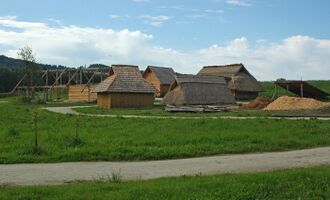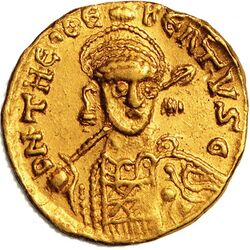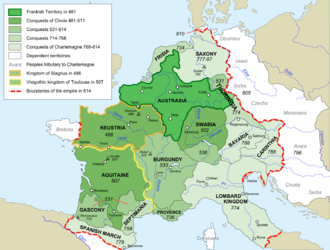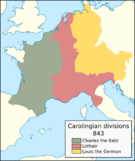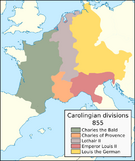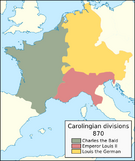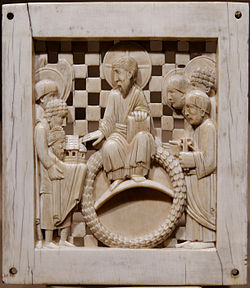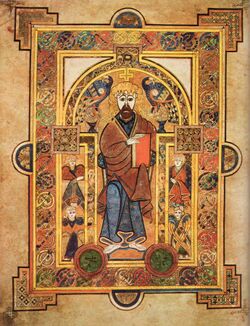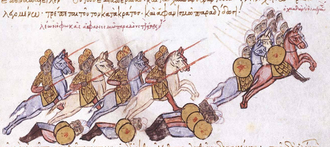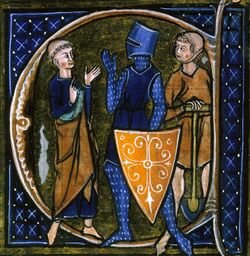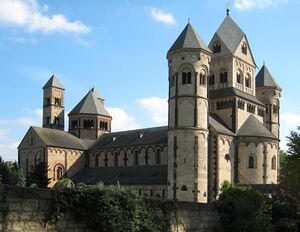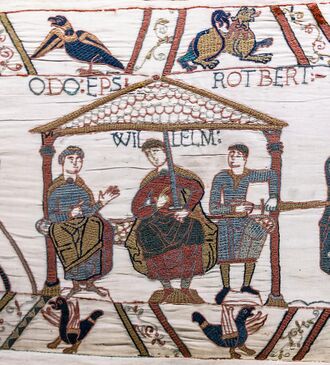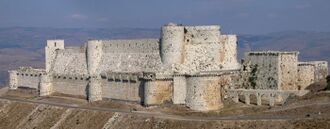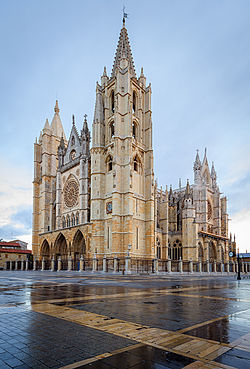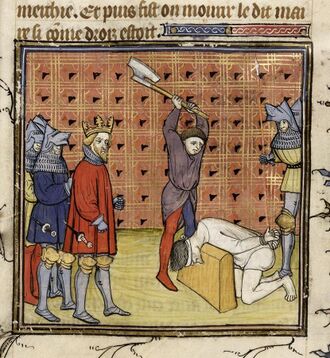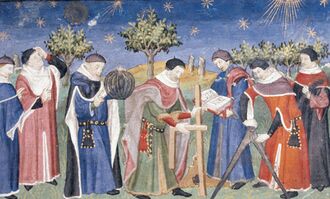Middle Ages
Topic: History
 From HandWiki - Reading time: 69 min
From HandWiki - Reading time: 69 min
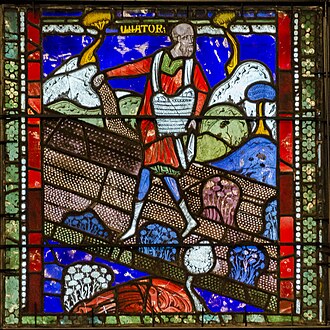
In the history of Europe, the Middle Ages or medieval period (also spelt mediæval or mediaeval) lasted approximately from 500 AD to 1500, although alternative starting and end points exist. The Middle Ages is the middle period of the three traditional divisions of Western history: antiquity, medieval, and modern. The medieval period is itself subdivided into the Early, High, and Late Middle Ages, and the early medieval period is alternatively referred to as the Dark Ages.
Population decline, counterurbanisation, the collapse of centralised authority, invasion and the mass migration of tribes, which had begun in late antiquity, continued into the Early Middle Ages. The large-scale movements of the Migration Period, including of Germanic peoples, led to the rise of new kingdoms in Western Europe. In the 7th century, the Middle East and North Africa came under caliphal rule with the Arab conquests. The Byzantine Empire survived in the Eastern Mediterranean and advanced secular law through the Code of Justinian. In the West, most kingdoms incorporated extant Roman institutions, while the influence of Christianity expanded across Europe. The Carolingian dynasty of the Franks established the Carolingian Empire during the later 8th and early 9th centuries in Western Europe before it succumbed to internal conflict and external invasions.
During the High Middle Ages, which began after 1000, the population of Europe increased greatly as technological and agricultural innovations allowed trade to flourish and the Medieval Warm Period climate change allowed crop yields to increase. Manorialism, the organisation of peasants into villages that owed rent and labour services to the nobles, and feudalism, the political structure whereby knights and lower-status nobles owed military service to their overlords in return for the right to rent from lands and manors, were two of the ways society was organised in the High Middle Ages. This period also saw the formal division of the Catholic and Orthodox churches, with the East–West Schism of 1054. The Crusades, which began in 1095, were military attempts by Western European Christians to regain control of the Holy Land from Muslims and also contributed to the expansion of Latin Christendom in the Baltic region and the Iberian Peninsula. In the West, intellectual life was marked by scholasticism, a philosophy that emphasised joining faith to reason, and by the founding of universities. The theology of Thomas Aquinas, the paintings of Giotto, the poetry of Dante and Chaucer, the travels of Marco Polo, and the Gothic architecture of cathedrals such as Chartres mark the end of this period.
The Late Middle Ages was marked by difficulties and calamities including famine, plague, and war, which significantly diminished the population of Europe; between 1347 and 1350, the Black Death killed about a third of Europeans. Controversy, heresy, and the Western Schism within the Catholic Church paralleled the interstate conflict, civil strife, and peasant revolts that occurred in the kingdoms. Cultural and technological developments transformed European society, concluding the Late Middle Ages and beginning the early modern period.
Terminology and periodisation
The Middle Ages is one of the three major periods in the most enduring scheme for analysing European history: Antiquity, the Middle Ages and the Modern Period.[1] Leonardo Bruni was the first historian to use tripartite periodisation in his History of the Florentine People (1442),[2] and it became standard with 17th-century German historian Christoph Cellarius.[3] The adjective medieval, meaning pertaining to the Middle Ages,[note 1][4] derives from medium aevum ('middle age'), a Neo-Latin term first recorded in 1604.[5]
Medieval writers divided history into periods such as the Six Ages or the Four Empires, and considered their time to be the last before the end of the world.[6] In their concept, their age had begun when Christ had brought light to mankind, contrasted with the spiritual darkness of previous periods. The Italian humanist and poet Petrarch (d. 1374) turned the metaphor upside down, stating that the age of darkness had begun when emperors of non-Italian origin assumed power in the Roman Empire.[7]
The Middle Ages customarily spans the period between around 500 and 1500 in academic studies but both the starting and the end years are uncertain.[8][9][10] A commonly given starting point, first used by Bruni, is 476—the year the last Western Roman Emperor was deposed.[11][2] As an alternative, the conversion of the Roman Emperor Constantine the Great (r. 306–337) to Christianity is mentioned. There is no universally agreed-upon end date either. Events such as the Fall of Constantinople in 1453, Christopher Columbus's first voyage to the Americas in 1492, or the Protestant Reformation in 1517 are the most frequently used dates.[12] Europe, as the historian Miri Rubin emphasises, "did not live to a single rhythm over this period": the Christianisation, or conversion of Europe to Christianity happened in waves between Roman times and the 14th century.[10]
Historians from Romance language-speaking countries tend to divide the Middle Ages into two parts: an earlier "High" and later "Low" period. English-speaking historians, following their German counterparts, generally subdivide the Middle Ages into three intervals: "Early", "High", and "Late".[13] In the 19th century, the entire Middle Ages were often referred to as the Dark Ages, but with the adoption of these subdivisions, use of this term was restricted to the Early Middle Ages in the early 20th century.[14] Historians who regard the Middle Ages as a Eurocentric concept tend to avoid its use for global history but studies on "Indian Middle Ages", "Muslim Middle Ages", and similar subjects are not exceptional.[15][16]
Sources
The systematic publication of medieval written sources began with the Rerum italicarum scriptores by Ludovico Muratori (d. 1750) which was followed by similar series such as the Monumenta Germaniae Historica in Germany, and the Rolls Series in the United Kingdom. These large collections mainly contain annals, chronicles and other narrative sources with a focus on the deeds of powerful men.[17] According to modern perceptions, most chronicles were written in monasteries but cathedral chapters, royal courts, and cities were also important centers of historical writing. Modern historians mainly treat medieval narratives cautiously as they are often filled with distorted facts or unrealistic information.[18] Documents of state or church administration, such as royal charters and chrysobulls, are indispensable sources for medieval history, although forged or backdated legal papers abound. Most cartularies—collections of charters—have survived in monasteries.[19] Further types of written sources include graffiti, seals, and letters.[20]
Since the 1950s, archaeology have significantly contributed to the study of the history of poorly documented regions and periods. However, chronological dating is still uncertain. Radiocarbon dating mainly covers a 60-year-long period, and dendrochronological analysis—the study of growth rings in trunks—is applicable only if wooden remains are available at the archaeological site.[21] As few detailed written records documenting peasant life remain from before the 9th century, surviving information available to historians also comes mainly from archaeology.[22] Medieval images and sculptures may provide useful information about everyday life but a critical approach is needed because irony, satire, and anachronism were popular stylistic devices of medieval artists.[23]
Later Roman Empire
The Roman Empire reached its greatest territorial extent during the 2nd century AD; the following two centuries witnessed the slow decline of Roman control over its outlying territories.[24] Runaway inflation, external pressure on the frontiers, and outbreaks of plague combined to create the Crisis of the Third Century, with emperors coming to the throne only to be rapidly replaced by new usurpers.[25] Military expenses steadily increased, mainly in response to the war with the Sasanian Empire.[26] The army doubled in size, and cavalry and smaller units replaced the legion as the main tactical unit.[27] The need for revenue led to increased taxes and a decline in numbers of the curial, or landowning, class.[26] More bureaucrats were needed in the central administration to deal with the needs of the army.[27]
The Emperor Diocletian (r. 284–305) split the empire into separately administered eastern and western halves in 286. This system, which eventually encompassed two senior and two junior co-emperors (hence known as the Tetrarchy) stabilised the imperial government for about two decades.[28] After a period of civil war, Constantine the Great restored internal peace, and refounded the city of Byzantium as the newly renamed eastern capital, Constantinople in 330.[29]
For much of the 4th century, Roman society stabilised in a new form that differed from the earlier classical period, with a widening gulf between the rich and poor, and a decline in the vitality of the smaller towns.[30] Another change was the Christianisation of the Roman Empire. It was accelerated by the conversion of Constantine but Christianity emerged as the empire's dominant religion only at the end of the 4th century.[31] Debates about Christian theology intensified, and those who persisted with theological views condemned at the ecumenical councils faced persecution. Such heretic views survived through proselytising campaigns outside the empire, or because of local ethnic groups' support in the eastern provinces, like Arianism among the Germanic peoples, or Monophysitism in Egypt and Syria.[32][33] Judaism remained a tolerated religion, although legislation limited Jews' rights.[34]
By the 3rd century, the Early Christians developed their own symbolism, often by reinterpreting popular motifs of pagan Roman art, and decorated their catacombs with frescoes depicting Biblical scenes.[35] The solemnity of the Later Roman artists' abstract style effectively visualised Christian messages.[36] Christ's enthroned figure became a principal element of Early Christian art in the early 4th century.[37] Under Constantine, basilicas, large halls that had been used for administrative and commercial purposes, were adapted for Christian worship.[38] The first illuminated manuscripts—hand-written books decorated with colourful miniatures—were produced in parallel with the spread of silent reading in the 5th century.[39]
Civil war between rival emperors became common in the middle of the 4th century, diverting soldiers from the empire's frontier forces and allowing invaders to encroach.[40] Although the movements of peoples during this period are usually described as "invasions", they were not just military expeditions but migrations into the empire.[41] In 376, hundreds of thousands of Goths, fleeing from the Huns, received permission from Emperor Valens (r. 364–78) to settle in Roman territory in the Balkans. The settlement did not go smoothly, and when Roman officials mishandled the situation, the Goths began to raid and plunder.[note 2] Valens, attempting to put down the disorder, was killed fighting the Goths at the Battle of Adrianople.[43] The Visigoths, a Gothic group, invaded the Western Roman Empire in 401; the Alans, Vandals, and Suevi crossed into Gaul in 406, and into modern-day Spain in 409. A year later the Visigoths sacked the city of Rome.[44][45] The Franks, Alemanni, and the Burgundians all ended up in Gaul while the Germanic groups now collectively known as Anglo-Saxons settled in Britain,[46] and the Vandals conquered the province of Africa.[47] The Hunnic king Attila (r. 434–53) led invasions into the Balkans in 442 and 447, Gaul in 451, and Italy in 452 but the Hunnic confederation he led fell apart after his death.[48]
When dealing with the migrations, the Eastern Roman elites combined the deployment of armed forces with gifts and grants of offices to the tribal leaders, whereas the Western aristocrats failed to support the army but also refused to pay tribute to prevent invasions by the tribes.[41] These invasions led to the division of the western section of the empire into smaller political units, ruled by the tribes that had invaded.[49] The emperors of the 5th century were often controlled by military strongmen such as Stilicho (d. 408), Aetius (d. 454), Aspar (d. 471), Ricimer (d. 472), or Gundobad (d. 516), who were partly or fully of non-Roman ancestry.[50] The deposition of the last emperor of the west, Romulus Augustulus (r. 475–76) has traditionally marked the end of the Western Roman Empire.[note 3][51] The Eastern Roman Empire, often referred to as the Byzantine Empire after the fall of its western counterpart, had little ability to assert control over the lost western territories although the Byzantine emperors maintained a claim over the territory.[52]
Early Middle Ages
Post-Roman kingdoms
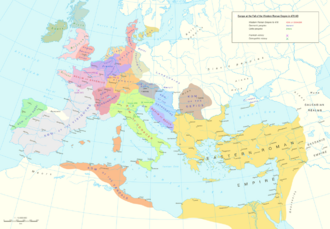
In the post-Roman world, the fusion of Roman culture with the customs of the invading tribes is well documented. Popular assemblies that allowed free male tribal members more say in political matters than had been common in the Roman state developed into legislative and judicial bodies.[53] Material artefacts left by the Romans and the invaders are often similar, and tribal items were often modelled on Roman objects.[54] Much of the scholarly and written culture of the new kingdoms was based on Roman intellectual traditions.[55] Many of the new political entities no longer supported their armies through taxes, instead relying on granting them land or rents. This meant there was less need for large tax revenues and so the taxation systems decayed.[56]
In Britain, the local Celtic Britons' culture had little impact on the Anglo-Saxons' way of life, but the linguistic assimilation of masses of the natives to the newcomers is evident. By around 600, new political centres emerged, some local leaders accumulated considerable wealth, and a number of small kingdoms such as Wessex and Mercia were formed. Smaller kingdoms in present-day Wales and Scotland were still under the control of the native Britons and Picts.[57] Ireland was divided into even smaller political units, perhaps as many as 150 tribal kingdoms.[58]
The Ostrogoths moved to Italy from the Balkans in the late 5th century under Theoderic the Great (r. 493–526). He set up a kingdom marked by its co-operation between the natives and the conquerors. Power struggles between Romanised and traditionalist Ostrogothic groups followed his death, providing the opportunity for the Byzantines to reconquer Italy.[59] The Burgundians settled in Gaul where they reorganised their kingdom.[60] Elsewhere in Gaul, the Franks and Celtic Britons set up stable polities. Francia was centred in northern Gaul, and the first king of whom much is known is Childeric I (d. 481). Under his son Clovis I (r. 509–11), the founder of the Merovingian dynasty, the Frankish kingdom expanded and converted to Christianity.[61] Unlike other Germanic peoples, the Franks accepted Catholicism which facilitated their cooperation with the native Gallo-Roman aristocracy.[62] Britons fleeing from Britannia – modern-day Great Britain – settled in what is now Brittany.[note 4][63]
Other monarchies were established by the Visigoths in the Iberian Peninsula, the Suebi in northwestern Iberia, and the Vandals in North Africa.[64] The Lombards settled in Northern Italy in 568 and established a new kingdom composed of town-based duchies.[65] Coming from the Asian steppes, the nomadic Avars conquered most Slavic, Turkic and Germanic tribes in the lowlands along the Lower and Middle Danube by the end of the 6th century, and they were routinely able to force the Eastern emperors to pay tribute.[66] Around 670, another steppe people, the Bulgars settled at the Danube Delta. In 681, they defeated a Byzantine imperial army, and established the First Bulgarian Empire, subjugating the local Slavic tribes.[67]
The settlement of peoples was accompanied by changes in languages. Latin, the literary language of the Western Roman Empire, was gradually replaced by vernacular languages which evolved from Latin, but were distinct from it, collectively known as Romance languages. Greek remained the language of the Byzantine Empire, but the migrations of the Slavs expanded the area of Slavic languages in Central and Eastern Europe.[68]
Byzantine survival
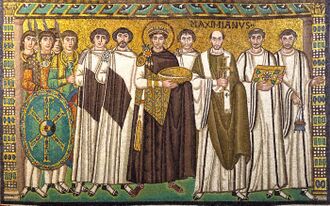
The Eastern Roman Empire remained intact and experienced an economic revival that lasted into the early 7th century. Here political life was marked by closer relations between the political state and Christian Church, with theological matters assuming an importance in Eastern politics that they did not have in Western Europe.[69] The Byzantines regularly employed eunuchs for administrative tasks, or as guardians or tutors to women and children, as they regarded castrated men as exceptionally intelligent and loyal servants.[70] Legal developments included the codification of Roman law;[71] the most comprehensive compilation, the Corpus Juris Civilis, took place under Emperor Justinian (r. 527–65).[72]
Justinian almost lost his throne during the Nika riots, a popular revolt that destroyed half of Constantinople in 532. After crushing the revolt, he reinforced the autocratic elements of the imperial government and mobilised his troops against the Arian western kingdoms. The general Belisarius (d. 565) conquered North Africa from the Vandals, and attacked the Ostrogoths, but the campaign was interrupted by an unexpected Sasanian invasion from the east. Between 541 and 543, a deadly outbreak of plague decimated the empire's population. Justinian ceased to finance the maintenance of public roads, and covered the lack of military personnel by developing an extensive system of border forts. In a decade, he resumed expansionism, completing the conquest of the Ostrogothic kingdom, and seizing much of southern Spain from the Visigoths.[73]
Justinian's reconquests and excessive building program have been criticised by historians for bringing his realm to the brink of bankruptcy, but many of the difficulties faced by Justinian's successors were because of other factors, including the epidemic and the massive expansion of the Avars and their Slav allies.[74] In the east, border defences collapsed during a new war with the Sasanian Empire, and the Persians seized large chunks of the empire, including Egypt, Syria, and much of Anatolia. In 626, the Avars, Slavs and Persians attacked Constantinople but could not conquer it. Two years later, Emperor Heraclius (r. 610–41) launched an unexpected counterattack against the heart of the Sassanian Empire, recovering all territories previously lost to the Persians.[75]
Western society
In Western Europe, some of the older Roman elite families died out while others became more involved with ecclesiastical than secular affairs. Values attached to Latin scholarship and education mostly disappeared. While literacy remained important, it became a practical skill rather than a sign of elite status. By the late 6th century, the principal means of religious instruction had become music and art rather than the book.[76] Most intellectual efforts went towards imitating classical scholarship, but some original works were created, along with now-lost oral compositions. The writings of Sidonius Apollinaris (d. 489), Cassiodorus (d. c. 585), and Boethius (d. c. 525) were typical of the age.[77] Aristocratic culture focused on great feasts rather than on literary pursuits. Family ties within the elites were important, as were the virtues of loyalty, courage, and honour. These ties led to the prevalence of the feud in aristocratic society. Most feuds seem to have ended quickly with the payment of some sort of compensation.[78]
Women took part in aristocratic society mainly in their roles as wives and mothers, with the role of mother of a ruler being especially prominent in Francia. In Anglo-Saxon society the lack of many child rulers meant a lesser role for women as queen mothers, but this was compensated for by the increased role played by abbesses of monasteries.[79] Women's influence on politics was particularly fragile, and early medieval authors tended to depict powerful women in a bad light.[note 5][81] Women usually died at considerably younger age than men, primarily owing to infanticide and complications at childbirth. The disparity between the numbers of marriageable women and grown men led to the detailed regulation of legal institutions protecting women's interests, including their right to the Morgengabe, or "morning gift".[82] Early medieval laws acknowledged a man's right to have long-term sexual relationships with women other than his wife, such as concubines, but women were expected to remain faithful. Clerics censured sexual unions outside marriage, and monogamy became also the norm of secular law in the 9th century.[83]
Landholding patterns were not uniform; some areas had greatly fragmented holdings, but in other areas large contiguous blocks of land were the norm. These differences allowed for a wide variety of peasant societies, some dominated by aristocratic landholders and others having a great deal of autonomy.[84] Land settlement also varied greatly. Some peasants lived in large settlements that numbered as many as 700 inhabitants, others on isolated farms.[85] As legislation made a clear distinction between free and unfree, there was no sharp break between the legal status of the free peasant and the aristocrat, and it was possible for a free peasant's family to rise into the aristocracy through military service.[86] Demand for slaves was covered through warring and raids. Initially, the Franks' expansion and conflicts between the Anglo-Saxon kingdoms supplied the slave market with prisoners of war and captives. After the Anglo-Saxons' conversion to Christianity, slave hunters mainly targeted the pagan Slav tribes—hence the English word "slave" from slavicus, the Medieval Latin term for Slavs.[87] Christian ethics brought about significant changes in the position of slaves in the 7th and 8th centuries. They were no more regarded as their lords' property, and their right to a decent treatment was enacted.[88]
Roman city life and culture changed greatly in the early Middle Ages. Although the northern Italian cities remained inhabited, they contracted significantly in size.[note 6][90] In Northern Europe, cities also shrank, while civic monuments and other public buildings were raided for building materials.[91] The Jewish communities survived in Spain, southern Gaul and Italy. The Visigothic kings made concentrated efforts to convert the Hispanic Jews to Christianity but the Jewish community quickly regenerated after the Muslim conquest of Spain.[92] Whereas Muslim rulers employed Jewish courtiers,[93] Christian legislation forbade the Jews' appointment to government positions.[94]
Rise of Islam

Religious beliefs were in flux in the lands along the Eastern Roman and Persian frontiers. State-sponsored Christian missionaries proselytised among the pagan steppe peoples, and the Persians made attempts to enforce Zoroastrianism on the Christian Armenians. Judaism was an active proselytising faith, and at least one Arab political leader—Dhu Nuwas, ruler of what is today Yemen—converted to it.[95] The emergence of Islam in Arabia during the lifetime of Muhammad (d. 632) brought about more radical changes. After his death, Islamic forces conquered Syria, Persia, and Egypt. The Eastern Romans halted the Muslim expansion at Constantinople in 674–78 and 717–18, but in the west, Islamic troops conquered North Africa by the early 8th century, annihilated the Visigothic Kingdom in 711, and invaded southern Gaul from 713.[96]
The Muslim conquerors bypassed the mountainous northwestern region of the Iberian Peninsula. Here a small kingdom, Asturias emerged as the centre of local resistance.[97] The defeat of Muslim forces at the Battle of Tours in 732 led to the reconquest of southern France by the Franks, but the main reason for the halt of Islamic growth in Europe was the overthrow of the Umayyad Caliphate and its replacement by the Abbasid Caliphate. The Abbasids were concerned with the Middle East, losing control of sections of the Muslim lands in the west. Umayyad descendants took over Al-Andalus (or Muslim Spain), the Aghlabids controlled North Africa, and the Tulunids became rulers of Egypt.[98] The Islamisation of the countryside in Al-Andalus was slow. Christians were regularly employed in state administration, but sometimes violent interreligious conflicts led to their mass migration to the north.[99] Apart from Byzantium, Muslim Spain was the only place in Europe where eunuchs played a preeminent role in administration and social life, holding positions such as guardians of religious shrines, or harem servants.[100]
Trade and economy
As the migrations and conquests disrupted trade networks throughout the old Roman lands, goods from long-range trade were replaced with local products. Non-local goods appearing in the archaeological record are usually luxury goods or metalworks.[101] In the 7th and 8th centuries, new commercial networks were developing in northern Europe. Goods like furs, walrus ivory and amber were delivered from the Baltic region to western Europe, triggering the establishment of toll stations and conflicts over their control.[102] In the post-Roman kingdoms, base metal coinage nearly ceased but Roman bronze coins remained in circulation for centuries. Although gold coins were struck, they were mainly spent for extraordinary expenditures, such as the purchase of land or luxury goods. A shift from gold coinage to the mint of silver pennies began in the late 7th century, not independently of the cessation of Byzantine subsidy payments to the Lombards and Franks. The elites' new emphasis on Christian charity also increased the demand for coins of lower value.[103]
The flourishing Islamic economies' constant demand for fresh labour force and raw materials opened up a new market for Europe around 750. Europe emerged as a major supplier of house slaves and slave soldiers for Al-Andalus, northern Africa and the Levant. Venice developed into the most important European center of slave trade.[104][105] In addition, timber, fur and arms were delivered from Europe to the Mediterranean, while Europe imported spices, medicine, incense, and silk.[106] The large rivers connecting distant regions facilitated the expansion of transcontinental trade.[107] Contemporaneous reports indicate that Anglo-Saxon merchants visited fairs at Paris, pirates preyed on tradesman on the Danube, and Eastern Frankish merchants reached as far as Zaragoza in Al-Andalus.[108]
Church life
The idea of Christian unity endured, although differences in ideology and practice between the Eastern and Western Churches became apparent by the 6th century.[109] The native Romans' aversion to the Arian conquerors reinforced the traditional Christian concept of the separation of church and state in the west, whereas this notion was alien to eastern clergymen who regarded the Roman state as an instrument of divine providence.[109] In the late 7th century, clerical marriage emerged as a permanent focus of controversy. After the Muslim conquests, the Byzantine emperors could less effectively intervene in the west. When Leo III (r. 717–41) prohibited the display of paintings representing human figures in places of worship, the papacy openly rejected his claim to declare new dogmas by imperial edicts.[110] Although the Byzantine Church condemned iconoclasm in 843, further issues such as fierce rivalry for ecclesiastic jurisdiction over newly converted peoples, and the unilateral modification of the Nicene Creed in the west widened to the extent that the differences were greater than the similarities.[111] In the west, the tithe, originally a voluntarily contribution, was levied as a regular church tax on agrarian products from the 10th century.[112]
Few of the Western bishops looked to the papacy for leadership. The only part of Western Europe where the papacy had influence was Britain, where Gregory the Great (pope 590–604) had sent a mission to convert the Anglo-Saxons to Christianity.[113] Irish missionaries were most active in Western Europe between the 5th and the 7th centuries.[114] People did not visit churches regularly. Instead, meetings with itinerant clergy and pilgrimages to popular saints' shrines were instrumental in the spread of Christian teaching. Clergymen used special handbooks known as penitentials to determine the appropriate acts of penance—typically prayers, and fasts—for sinners. They placed a special emphasis on sexuality and prescribed severe penances for adulterers, fornicators and those engaged in non-reproductive sexual acts, such as homosexuals.[115] In contrast with official Christianity, the Bogomils of the Balkans condemned sexual reproduction as they regarded Satan the creator of the physical universe.[116]
The Early Middle Ages witnessed the rise of Christian monasticism. Monastic ideals spread from Egypt through hagiographical literature, especially the Life of Anthony. Most European monasteries were of the type that focuses on community experience of the spiritual life, called cenobitism.[117] The Italian monk Benedict of Nursia (d. 547) developed the Benedictine Rule which became widely used in western monasteries.[118] In the east, the monastic rules compiled by Theodore the Studite (d. 826) gained popularity after they were adopted in the Great Lavra on Mount Athos in the 960s, turning the mount into the most important centre of Orthodox monasticism.[119]
Monks and monasteries had a deep effect on religious and political life, in various cases acting as land trusts for powerful families and important centres of political authority.[120] They were the main and sometimes only outposts of education and literacy in a region. Many of the surviving manuscripts of the Latin classics were copied in monasteries.[121] Monks were also the authors of new works, including history, theology, and other subjects, written by authors such as Bede (d. 735), a native of northern England.[122] The erudite Saxon nun Hrosvitha (d. 1000) authored the first non-liturgical medieval dramas.[123][124] The Byzantine missionary Constantine (d. 869) developed Old Church Slavonic as a new liturgical language, establishing the basis for flourishing Slavic religious literature; around 900 a new script was adopted for it, now known for Constantine's monastic name as Cyrillic.[125]
In Western Christendom, lay influence over Church affairs came to a climax in the 10th century. Aristocrats regarded the churches and monasteries under their patronage as their personal property, and simony—the sale of Church offices—was a common practice. Simony aroused a general fear as many believed that irregularly appointed priests could not confer valid sacraments such as baptism.[126] Monastic communities were the first to react to this fear by the rigorous observance of their rules. The establishment of Cluny Abbey in Burgundy in 909 initiated a more radical change as Cluny was freed from lay control and placed under the protection of the papacy. The Cluniac Reforms spread through the founding of new monasteries and the reform of monastic life in old abbeys.[127] Cluny's example indicated that the reformist idea of the "Liberty of the Church" could be achieved through submission to the papacy.[128]
Carolingian Europe
The Merovingian kings customarily distributed Francia among their sons and destroyed their own power base by extensive land grants. In the northeastern Frankish kingdom Austrasia, the Arnulfings were the most prominent beneficiaries of royal favour. As hereditary Mayors of the Palace, they were the power behind the throne from the mid-7th century. One of them, Pepin of Herstal (d. 714), also assumed power in the central Frankish realm Neustria. His son Charles Martel (d. 741) took advantage of the permanent Muslim threat to confiscate church property and raise new troops by parcelling it out among the recruits.[129]
The Carolingians, as Charles Martel's descendants are known, succeeded the Merovingians as the new royal dynasty of Francia in 751. This year the last Merovingian king Childeric III (r. 743–51) was deposed, and Charles Martel's son Pepin the Short (r. 751–68) was crowned king with the consent of the Frankish leaders and the papacy. Pepin attacked the Lombards and enforced their promise to respect the possessions of the papacy. His subsequent donation of Central Italian territories to the Holy See marked the beginnings of the Papal States.[130][131]
Pepin left his kingdom in the hands of his two sons, Charles, more often known as Charlemagne (r. 768–814), and Carloman (r. 768–71). When Carloman died of natural causes, Charlemagne reunited Francia and embarked upon a programme of systematic expansion, rewarding allies with war booty and command over parcels of land. He subjugated the Saxons, conquered the Lombards, and created a new border province in northern Spain.[132] Frankish troops also destroyed the Avars which facilitated the development of small Slavic principalities, mainly ruled by ambitious warlords under Frankish suzerainty.[note 7][134] The coronation of Charlemagne as emperor on Christmas Day 800 marked a return of the Western Roman Empire although the Byzantines did not recognise him as a second "emperor of the Romans".[135]
The empire was administered by an itinerant court that travelled with the emperor, as well as approximately 300 imperial officials called counts, who administered the counties the empire had been divided into.[136] The central administration supervised the counts through imperial emissaries called missi dominici. They served as roving inspectors and troubleshooters. The clerics of the royal chapel were responsible for recording important royal grants and decisions.[137]
Charlemagne's court in Aachen was the centre of the cultural revival sometimes referred to as the "Carolingian Renaissance". Literacy increased, as did development in the arts, architecture and jurisprudence, as well as liturgical and scriptural studies under the auspices of the Anglo-Saxon scholar Alcuin (d. 804). He developed a new script, today known as Carolingian minuscule, which facilitated reading by the clear separation of words, and the use of extensive punctuation and transparent sectioning. Charlemagne sponsored changes in church liturgy, imposing the Roman form of church service on his domains, as well as the Gregorian chant in liturgical music for the churches. An important activity for scholars during this period was the copying, correcting, and dissemination of basic works on religious and secular topics, with the aim of encouraging learning. New works on religious topics and schoolbooks were also produced.[note 8][139]
Breakup of the Carolingian Empire
Charlemagne continued the Frankish tradition of dividing his empire between all his sons, but only one son, Louis the Pious (r. 814–40), was still alive by 813. Louis's reign was marked by numerous divisions of the empire among his sons, and civil wars between various alliances of father and sons. Three years after his death, his three surviving sons divided the empire among themselves by the Treaty of Verdun.[140] A kingdom between the Rhine and Rhone rivers was created for Lothair I (r. 817–55) to go with his lands in Italy, and his imperial title was recognised. Louis the German (r. 843–76) was in control of the eastern lands in modern-day Germany. Charles the Bald (r. 843–77) received the western Frankish lands, comprising most of modern-day France.[141] Charlemagne's grandsons and great-grandsons divided their kingdoms between their descendants, eventually causing all internal cohesion to be lost.[142]
There was a brief re-uniting of the empire by Charles the Fat in 884, although the actual units of the empire retained their separate administrations.[143] By the time he died early in 888, the Carolingians were close to extinction, and non-dynastic claimants assumed power in most of the successor states, such as the Parisien count Odo in Francia (r. 888–98).[144] In the eastern lands the dynasty died out with the death of Louis the Child (r. 899–911), and the selection of the Franconian duke Conrad I (r. 911–18) as king.[145] In West Francia, the dynasty was restored first in 898, then in 936, but the last Carolingians were unable to keep the aristocracy under control. In 987 the dynasty was replaced, with the crowning of Hugh Capet (r. 987–96) as king.[note 9][146] Although the Capetian kings remained nominally in charge, much of the political power devolved to the local lords.[147]
Frankish culture and the Carolingian methods of state administration had a significant impact on the neighboring peoples. Frankish threat triggered the formation of new states along the empire's eastern frontier—Bohemia, Moravia, and Croatia.[148] The breakup of the Carolingian Empire was accompanied by invasions, migrations, and raids by external foes. The Atlantic and northern shores were harassed by the Vikings, who also raided the British Isles and settled there. In 911, the Viking chieftain Rollo (d. c. 931) received permission from the Frankish king Charles the Simple (r. 898–922) to settle in what became Normandy. The eastern parts of the Frankish kingdoms, especially Germany and Italy, were under continual Magyar assault until the invaders' defeat at the Battle of Lechfeld in 955.[149] In the Mediterranean, Arab pirates launched regular raids against Italy and southern France, and the Muslim states began expanding. The Aghlabids conquered Sicily, and the Umayyads of Al-Andalus annexed the Balearic Islands.[150]
New kingdoms and Byzantine revival
The Vikings' settlement in the British Isles led to the formation of new political entities, including the small but militant Kingdom of Dublin in Ireland.[151] The Anglo-Saxon king Alfred the Great (r. 871–99) came to an agreement with the Danish invaders in 879, acknowledging the existence of an independent Viking realm in Britain.[152][153] By the middle of the 10th century, Alfred's successors had restored English control over the territory.[154] In northern Britain, Kenneth MacAlpin (d. c. 860) united the Picts and the Scots into the Kingdom of Alba.[155] In the early 10th century, the Ottonian dynasty established itself in Germany, and was engaged in driving back the Magyars and fighting the disobedient dukes. After an appeal by the widowed Queen Adelaide of Italy (d. 999) for protection, Otto I (r. 936–73) crossed the Alps into Italy, married the young widow and had himself crowned king in Pavia in 951. His coronation as Holy Roman Emperor in Rome in 962 demonstrated his claim to Charlemagne's legacy.[156] Otto's successors remained keenly interested in Italian affairs but the absent German kings were unable to assert permanent authority over the local aristocracy.[157] In the Iberian Peninsula, the Basques' fight for independence led to the formation of the small Kingdom of Navarre in the Pyrenees, and the counts of Barcelona gained autonomy in the Carolingian border province. Asturias expanded slowly south, and continued as the Kingdom of León in the 10th century.[158][159]
The Eastern European trade routes towards Asia were controlled by the Khazars. Their multiethnic empire resisted the Muslim expansion, and their leaders converted to Judaism.[160] At the end of the 9th century, a new trade route developed, bypassing Khazar territory and connecting Central Asia with Europe across Volga Bulgaria; here the local inhabitants converted to Islam.[161] In Scandinavia, contacts with Francia paved the way for missionary efforts by Christian clergy, and Christianisation was closely associated with the growth of centralised kingdoms in Denmark, Norway, and Sweden. Swedish traders and slave hunters ranged down the rivers of the East European Plain, captured Kyiv from the Khazars, and even attempted to seize Constantinople in 860 and 907.[162] Norse colonists settled in Iceland and created a political system that hindered the accumulation of power by ambitious chieftains.[163]
Byzantium revived its fortunes under Emperor Basil I (r. 867–86) and his successors Leo VI (r. 886–912) and Constantine VII (r. 913–59), members of the Macedonian dynasty. Commerce revived and the emperors oversaw the extension of a uniform administration to all the provinces. The imperial court was the centre of a revival of classical learning, a process known as the Macedonian Renaissance. The military was reorganised, which allowed the emperors John I (r. 969–76) and Basil II (r. 976–1025) to expand the frontiers of the empire.[164]
Missionary efforts by both Eastern and Western clergy resulted in the conversion of the Moravians, Danubian Bulgars, Czechs, Poles, Magyars, and the inhabitants of the Kievan Rus'.[165] Moravia fell victim to Magyar invasions around 900, Bulgaria to Byzantine expansionism between 971 and 1018.[148][166] After the fall of Moravia, dukes of the Czech Přemyslid dynasty consolidated authority in Bohemia.[167] In Poland, the destruction of old power centres accompanied the formation of state under the Piast dukes.[168] In Hungary, the princes of the Árpád dynasty applied extensive violence to crush opposition by rival Magyar chieftains.[169] The Rurikid princes of Kievan Rus' emerged as the hegemon power of East Europe's vast forest zones after Rus' raiders sacked the Khazar capital Atil in 965.[170]
Architecture and art
New basilicas were built in the major Roman cities and the post-Roman kingdoms in the 4th–6th centuries.[note 10][171] In the late 6th century, Byzantine church architecture adopted an alternative model imitating the rectangular plan and the dome of Justinian's Hagia Sophia, the largest single roofed structure of the Roman world.[172] As the spacious basilicas became of little use with the decline of urban centres in the west, they gave way to smaller churches. By the beginning of the 8th century, the Carolingian Empire revived the basilica form of architecture.[173] One new standard feature of Carolingian basilicas is the use of a transept, or the "arms" of a T-shaped building that are perpendicular to the long nave.[174] An extraordinary monument of Moorish architecture is the former Great Mosque of Córdoba—now the city's cathedral church—with a forest of reused Roman columns supporting a double line of red-and-white-striped arches.[175]
Magnificent halls built of timber or stone were the centres of political and social life. Their design often adopted elements of Later Roman architecture like pilasters, columns, and sculptured discs.[note 11][176] After the disintegration of the Carolingian Empire, the spread of aristocratic castles indicates a transition from communal fortifications to private defence in western Europe. Most castles were wooden structures but the wealthiest lords built stone fortresses.[note 12] One or more towers, now known as keeps, were their most characteristic features but castles often developed into multifunctional compounds with their drawbridges, fortified courtyards, cisterns or wells, halls, chapels, stables and workshops.[178]
In the age of mass migrations, gold pouring to the tribal leaders from the Roman Empire was regularly remoulded into new artifacts, such as massive necklaces, and eagle-shaped fibulae by local goldsmiths. Their unrealistic style, often influenced by Iranian polychrome and cloisonné metalworks, was introduced into Roman territory by the invading peoples.[179] Artisans working for post-Roman elites developed a distinctly abstract design, characterised by ribbons and highly stylised animal motifs.[180] Literary works, like the Old English epic poem Beowulf, and the Nordic sagas refer to great royal treasures but only a few of them survived, including the grave goods from Childeric's tomb at Tournai, and the rich Anglo-Saxon burial at Sutton Hoo. Religious art quickly assimilated several elements of the post-Roman secular style, such as strapwork ornamenting, and extensive segmentation.[181] Paintings have mainly survived in richly decorated Gospel Books, including the Book of Kells and the Book of Lindisfarne—two representative works of the Insular art of Ireland and Northumbria.[note 13][183]
The Hellenistic tradition of realistic portrayal survived in the Mediterranean.[184] Although the iconoclastic movement restricted Byzantine art, the iconophiles' triumph paved the way for an artistic renewal.[note 14][186] The more naturalistic Mediterranean style served as an important source of inspiration for western artists under Charlemagne who treated visual arts as a powerful instrument of education and propaganda.[187] After a long pause, Carolingian art rediscovered the human figure, and western artists often depicted people in illuminated codices.[note 15] These were often protected by sumptuous book covers, made of gold, pearls, and polished gemstones.[188] Charlemagne's court seems to have been responsible for the acceptance of figurative monumental sculpture in Christian art,[189] and by the end of the period near life-sized figures such as the Gero Cross were common in important churches.[190] In England, book illuminators freely enriched their Insular heritage with Carolingian motifs, such as sprigs of foliage. In Germany, manuscripts illustrated with lively pictorial cycles indicate the direct impact of contemporary Byzantine art on Ottonian artists. In Christian Spain, artists adopted Islamic decorative motifs such as Kufic letters and Moorish arches.[191]
Military and technology
During the later Roman Empire, the principal military developments were attempts to create an effective cavalry force as well as the continued development of highly specialised types of troops. The creation of heavily armoured cataphract-type soldiers as cavalry was an important feature of the Late Roman military. The various invading tribes had differing emphases on types of soldiers—ranging from the primarily infantry Anglo-Saxon invaders of Britain to the Vandals and Visigoths who had a high proportion of cavalry in their armies.[192] The greatest change in military affairs was the adoption of the Hunnic composite bow in place of the earlier, and weaker, Scythian composite bow.[193] The Avar heavy cavalry introduced the use of stirrups in Europe,[194] and it was adopted by Byzantine cavalrymen before the end of the 6th century.[195] Another development was the increasing use of longswords and the progressive replacement of scale armour by mail and lamellar armour.[196]
The importance of infantry and light cavalry began to decline during the early Carolingian period, with a growing dominance of elite heavy cavalry, although a large proportion of the armies appear to have been mounted infantry, rather than true cavalry.[197] The use of militia-type levies of the free population declined. One exception was Anglo-Saxon England, where the armies were still composed of regional levies, known as the fyrd.[198] In military technology, one of the main changes was the reappearance of the crossbow as a military weapon.[199] A technological advance that had implications beyond the military was the horseshoe, which allowed horses to be used in rocky terrain.[200]
High Middle Ages
Society
Between around 950 and 1060, severe draughts hit the Middle East, and the Eurasian Steppe experienced cold anomalies. The ensuing famines led to riots and military coups in the Byzantine Empire, the Abbasid Caliphate, and Egypt, and forced masses of nomadic Turks to seek new pasturelands in Iraq, Anatolia, and the Balkans. Their influx caused much destruction, and culminated in the establishment of the Seljuk Empire in the Middle East.[201] In Europe, a period of tremendous population expansion began, and the estimated population grew from 35 to 80 million between around 1000 and 1347. The exact causes remain unclear: improved agricultural techniques, assarting (or bringing new lands into production), a more clement climate and the lack of invasion have all been suggested.[202][203]
Most medieval western thinkers divided the society into three fundamental classes. These were the clergy, the nobility, and the commoners. Constituting about 98 per cent of the total population, commoners were mainly rural peasants and artisans. The number of townspeople was growing but never exceeded 10 per cent of the total population.[204][205] Feudalism regulated fundamental social relations in many parts of Europe. In this system, one party granted property, typically land to the other in return for services, mostly of military nature that the recipient, or vassal, had to render to the grantor, or lord.[206][207] In other parts of Europe, such as Germany, Poland, and Hungary, inalienable allods remained the dominant forms of landholding. Their owners owed homage to the king or a higher-ranking aristocrat but their landholding was free of feudal obligations.[208][209]
Many of the peasantry were no longer settled in isolated farms but had gathered into more defensible small communities, usually known as manors or villages.[202][210] In the system of manorialism, a manor was the basic unit of landholding, and it comprised smaller components, such as parcels held by peasant tenants, and the lord's demesne.[211] As churchmen prohibited the enslavement of coreligionists, a new form of dependency (serfdom) almost completely supplanted slavery by the late 11th century. Unlike slaves, serfs had legal capacity, and their hereditary status was regulated by agreements with their lords. Restrictions on their activities varied but their freedom of movement was customarily limited, and they usually owed corvées, or labor services.[212][213] Peasants left their homelands in return for significant economic and legal privileges, typically a lower level of taxation and the right to administer justice at local level. The crossborder movement of masses of peasantry had radical demographic consequences, such as the spread of German settlements to the east, and the expansion of the Christian population in Iberia.[214]
With the development of heavy cavalry, the previously uniform class of free warriors split into two groups. Those who could equip themselves as mounted knights were integrated into the traditional aristocracy, but others were assimilated into the peasantry.[215] The new elite's position was stabilised through the adoption of strict inheritance customs, such as primogeniture—the eldest son's right to inherit the family domains undivided.[216] Nobles were stratified in terms of the land and people over whom they held authority; the lowest-ranking nobles did not hold land and had to serve wealthier aristocrats.[note 16][218] The nobility was never a closed group: kings could raise commoners to the aristocracy, wealthy commoners could marry into noble families, and impoverished aristocrats could lose their privileged status.[219] Western aristocrats often moved to the peripheries of Latin Christendom either with the support of local rulers who appreciated their military skills, or as conquerors.[note 17] French-speaking noblemen mainly settled in the British Isles, southern Italy or Iberia, whereas the German aristocrats preferred Central and Eastern Europe.[221]
The clergy was divided into two types. The secular clergy cared for believers' spiritual needs, mainly serving in the parish churches, whereas the regular clergy lived under a religious rule as monks, canons, or friars.[222] The introduction of clerical celibacy—the ban on priestly marriage—clearly distinguished Catholic clergy from laity.[223] Church courts had exclusive jurisdiction over marriage affairs,[224] and church authorities supported popular peace movements in the west.[225] From the early 13th century, laypeople were obliged to confess their sins to a priest at least once a year which reinforced priestly control of their life.[226] Individuals who were thought to receive divine revelations might present a challenge to clerical monopolies but most of them respected official doctrines. The veneration of popular mystics, such as Francis of Assisi (d. 1226), was often sanctioned by church authorities.[227] Jewish mysticism culminated in the compilation of the Zohar ('The Book of Illumination'), a 13th-century summary of kabbalistic teaching.[228]
Women were officially required to be subordinate to some male, whether their father, husband, or other kinsman. Women's work generally consisted of household or other domestically inclined tasks such as child-care. Peasant women could supplement the household income by spinning or brewing at home, and they also did field-work at harvest-time.[229] Townswomen could engage in trade but often only by right of their husband, and unlike their male competitors, they were not always allowed to train apprentices.[230] Noblewomen could inherit land in the absence of a male heir but their potential to give birth to children was regarded as their principal virtue.[231] As women were not ordained priests, the only role open to them in the Church was that of nuns,[232] but many popular mystics were women.[233] Among them, the nun Hildegard of Bingen (d. 1179/80) was a prolific and highly respected scholar, who proudly stated that "no man can be made without a woman".[note 18][235][234]
Trade and economy
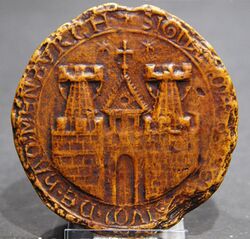
The expansion of population, greater agricultural productivity and relative political stability laid the foundations for the medieval "Commercial Revolution" in the 11th century.[236] People with surplus cash began investing in commodities like salt, pepper and silk at faraway markets.[237] Rising trade brought new methods of dealing with money, and gold coinage was again minted in Europe, first in Florence and Genoa. New forms of commercial contracts emerged, allowing risk to be shared within the framework of partnerships known as commenda or compagnia.[238] Bills of exchange also appeared, enabling easy transmission of money. As many types of coins were in circulation, money changers facilitated transactions between local and foreign merchants. Loans could also be negotiated with them which gave rise to the development of credit institutions called banks.[239]
As new towns were developing from local commercial centres, the economic growth brought about a new wave of urbanisation. Kings and aristocrats mainly supported the process in the hope of increased tax revenues.[240] Most urban communities received privileges acknowledging their autonomy, but few cities could get rid of all elements of royal or aristocratic control.[241] Townspeople engaged in the same trade or profession were united in confraternities known as guilds. Typically, these associations set the rules for quality, training, and pricing, and only their members had access to the local market.[242][243]
The Italian maritime republics such as Amalfi, Venice, Genoa, and Pisa were the first to profit from the revival of commerce in the Mediterranean.[236] In the north, German merchants established associations known as hansas and took control of the trade routes connecting the British Islands and the Low Countries with Scandinavia and Eastern Europe.[note 19][245] Great trading fairs were established and flourished in northern France, allowing Italian and German merchants to trade with each other as well as local merchants.[246]
Economic growth provided opportunities to Jewish merchants to spread all over Europe with the local rulers' support.[247] As the Jews could not engage in prestigious trades outside their communities, they often took despised jobs such as ragmen or tax collectors.[248] They were especially active in moneylending for they could ignore the Christian clerics' condemnation on loan interest.[249] The Jewish moneylenders and pawn brokers reinforced antisemitism, which led to blood libels and pogroms. Church authorities' growing concerns about Jewish influence on Christian life inspired segregationist laws,[note 20] and even their permanent expulsion from England in 1290.[251]
Technology and military
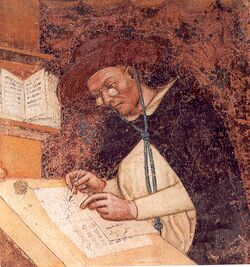
Technology developed mainly through minor innovations and by the adoption of advanced technologies from Asia through Muslim mediation.[252] Major technological advances included the first mechanical clocks and convex spectacles, and the manufacture of distilled spirits.[253][254] In Europe, horizontal treadle looms were introduced in the 11th century, windmills were first built after 1100, and spinning wheels appeared around 1200.[253][255] Large scale construction projects advanced building technology, and increased demand for raw materials like timber, stone, and bricks.[256] Shipbuilding improved with the use of the rib and plank method rather than the old Roman system of mortise and tenon. Other improvements to ships included the use of lateen sails and the stern-post rudder, both of which increased the speed at which ships could be sailed.[257] The use of astrolabe and compass allowed navigation in large distance from the shores.[258]
The development of a three-field rotation system for planting crops[note 21] increased the usage of land by more than 30 per cent, with a consequent increase in production.[259] The development of the heavy plough allowed heavier soils to be farmed more efficiently. The spread of horse collar led to the use of draught horses that required less pastures than oxen.[260] Legumes—such as peas, beans, or lentils—were grown more widely, in addition to the cereal crops.[261]
In military affairs, the use of infantry with specialised roles increased. Along with the still-dominant heavy cavalry, armies often included mounted and infantry crossbowmen, as well as sappers and engineers.[262] Crossbows increased in use partly because of the increase in siege warfare.[note 22][199] This led to the use of closed-face helmets, heavy body armour, as well as horse armour during the 12th and 13th centuries.[264] In contrast, the Mongols remained lightly armoured steppe horsemen even after they had adopted Chinese military devices.[note 23] The extensive use of spies for reconnoitering enemy lands was a prominent factor in their successful military campaigns.[266]
Church life
In the early 11th century, papal elections were controlled by Roman aristocrats, but Emperor Henry III (r. 1039–56) broke their power and placed reform-minded clerics on the papal throne. Through popular support, they achieved the acknowledgement of their supreme jurisdiction in church affairs in many parts of Europe.[267] In contrast, the head of the Byzantine Church Patriarch Michael I Cerularius (d. 1059) refused papal supremacy for which a papal legate excommunicated him in 1054. Eventually, after a string of mutual excommunications, this event, known as the East–West Schism, led to the separation of the Roman Catholic and Eastern Orthodox Churches.[268][269]
Lay investiture—the appointment of clerics by secular rulers—was condemned at an assembly of bishops in Rome in 1059, and the same synod established the exclusive right of the College of Cardinals to elect the popes.[270] Henry's son and successor Henry IV (r. 1056–1105) wanted to preserve the right to appoint his own choices as bishops within his lands but his appointments outraged Pope Gregory VII (pope 1073–85). Their quarrel developed into the Investiture Controversy, involving other powers as well because kings did not relinquish the control of appointments to bishoprics voluntarily. All conflicts ended with a compromise, in the case of the Holy Roman Emperors with the 1122 Concordat of Worms.[note 24][272][273]
The High Middle Ages was a period of great religious movements.[274] Old pilgrimage sites such as Rome, Jerusalem, and Compostela received increasing numbers of visitors, and new sites such as Monte Gargano and Bari rose to prominence.[275] Popular movements emerged to support the implementation of the church reform but their anticlericalism sometimes led to the rejection of Catholic dogmas by the most radical groups such as the Waldensians and Cathars.[276][277] To suppress heresies, the popes appointed special commissioners of investigation known as inquisitors.[278] Monastic reforms continued as the Cluniac monasteries' splendid ceremonies were alien to those who preferred the simpler hermetical monasticism of early Christianity, or wanted to live the "Apostolic life" of poverty and preaching. New monastic orders were established, including the Carthusians and the Cistercians. In the 13th century mendicant orders—the Franciscans and the Dominicans—who earned their living by begging, were approved by the papacy.[279]
Rise of state power
The High Middle Ages saw the development of institutions that would dominate political life in Europe until the late 18th century, or even later.[280] The kings' right to rule without a foreign power's intercession became widely accepted, inducing the idea of state sovereignty.[note 25][282] The concept of hereditary monarchy was strengthening,[283] and the first queens regnant assumed power, as female succession was recognised in most countries.[note 26][285] The chancery emerged as the central office of royal government but also acted as a court of appeals.[286] Taxation quickly developed because revenues from the royal domains could no more cover state expenditures. Initially, extraordinary taxes were levied for military purposes but by the end of the period taxes had been collected on a more regular basis.[287] Effective taxation depended on consent which reinforced the role of representative assemblies, allowing them to exert influence on state administration.[288][289]
The papacy, long attached to an ideology of independence from secular influence, first asserted its claim to temporal authority over the entire Christian world.[290] The Papal Monarchy reached its apogee under the pontificate of Innocent III (pope 1198–1216).[291] The popes who were rulers of much of central Italy and feudal overlords of some of the Catholic rulers such as the Sicilian kings were deeply involved in secular politics.[292] Sicily and southern Italy had been seized by Norman warbands from the local Lombard, Byzantine and Muslim rulers between 1016 and 1091, and Roger II (r. 1105–54) united the Norman principalities into the Kingdom of Sicily.[293]
In the Holy Roman Empire, the Ottonians were replaced by the Salians in 1024. They protected the lesser nobility to reduce ducal power, and seized Burgundy before clashing with the papacy under Henry IV.[294] After a short interval between 1125 and 1137, the Hohenstaufens succeeded the Salians. Their recurring conflicts with the papacy allowed the northern Italian cities and the German princes to extort considerable concessions from them. In 1183, Frederick I Barbarossa (r. 1155–90) sanctioned the right of the Lombard cities to elect their leaders; the princes' autonomy was recognised during the reign of his grandson Frederick II (r. 1220–50).[295] Frederick was famed for his erudition and unconventional life style[note 27] but his efforts to rule Italy eventually led to the fall of his dynasty. In Germany, a period of interregnum, or rather civil war began, whereas Sicily—Frederick's maternal inheritance—was seized by an ambitious French prince Charles I of Anjou (r. 1266–85).[297] During the civil war, the right of seven prince-electors to elect the king was reaffirmed. Rudolf of Habsburg (r. 1273–91), the first German king to be elected after the interregnum, realised that he was unable to control the whole empire. He granted Austria to his sons, thus establishing the basis for the Habsburgs' future dominance in Central Europe.[298][299] After his death, the peasantry of three Alpine communities formed the Swiss Confederacy to defend their judicial autonomy against his kinsmen.[300][301]
The French monarchy slowly began to expand its authority over the nobility.[302] The kings faced a powerful rival in the Dukes of Normandy, who in 1066 under William the Conqueror (r. 1035–87) conquered England. This cross-Channel empire further expanded when Henry II (r. 1154–89) from the Angevin dynasty ascended the throne, as he had seized large areas of France through inheritance and marriage.[note 28][304] The first Anglo-Norman lordships in Ireland were established during his reign.[305] Under his son Richard I (r. 1189–99), the Angevin Empire remained intact, but Richard's brother John (r. 1199–1216) lost the northern French possessions to the French king Philip II Augustus (r. 1180–1223).[306] John's financial exactions to pay for his unsuccessful attempts to regain Normandy led in 1215 to Magna Carta, a charter that confirmed the rights and privileges of free men in England.[307] In France, Philip Augustus's son Louis VIII (r. 1223–26) distributed large portions of his father's conquests among his younger sons as appanages—virtually independent provinces—to facilitate their administration.[308] His son Louis IX (r. 1226–70) improved local administration by appointing inspectors known as enquêteurs to oversee the royal officials' conduct. The royal court at Paris began hearing litigants in regular sessions almost all over the year.[309]
The Iberian Christian states began to push back against the Islamic powers in the south, a period known as the Reconquista.[310] After numerous divisions and reunifications of the Christian states, the Christian north had coalesced into the four kingdoms of Castile, Aragon, Navarre, and Portugal by 1230.[311][312] Aragon emerged as a naval power, conquering the Balearic Island from the Muslims, Sicily from the Italian Angevins, and Sardinia from the Genoese.[313][314] Southern Iberia remained under the control of Islamic states, initially under the Caliphate of Córdoba, which broke up in 1031 into a shifting number of petty states known as taifas. Although the Almoravids and the Almohads, two dynasties from the Maghreb, established centralised rule over Southern Iberia in the 1110s and 1170s respectively, their empires quickly disintegrated, allowing further expansion of the Christian kingdoms.[315] The Catholic Scandinavian states also expanded: the Norwegian kings assumed control of the Norse colonies in Iceland and Greenland, Denmark seized parts of Estonia, and the Swedes conquered Finland.[316]
In the east, Kievan Rus' fell apart into independent principalities. Among them, the northern Vladimir-Suzdal emerged as the dominant power after Suzdalian troops sacked Kyiv in 1169.[317] Poland also disintegrated into autonomous duchies, enabling the Czech kings to expand in the prosperous Duchy of Silesia.[318] The kings of Hungary seized Croatia but respected the liberties of the native aristocracy. They claimed (but only periodically achieved) suzerainty over other lands and peoples such as Dalmatia, Bosnia, and the nomadic Cumans.[319] The Cumans supported the Bulgarians and Vlachs during their anti-Byzantine revolt that led to the restoration of Bulgaria in the late 12th century.[320] To the west of Bulgaria, Serbia gained independence.[321]
With the rise of the Mongol Empire in the Eurasian steppes under Genghis Khan (r. 1206–27), a new expansionist power reached Europe's eastern borderlands.[322] Between 1236 and 1242, the Mongols conquered Volga Bulgaria, shattered the Rus' principalities, and laid waste to large regions in Poland, Hungary, Croatia, Serbia and Bulgaria. Their commander-in-chief Batu Khan (r. 1241–56)—a grandson of Genghis Khan—set up his capital at Sarai on the Volga, establishing the Golden Horde, a Mongol state nominally under the distant Great Khan's authority. The Mongols extracted heavy tribute from the Rus' principalities, and the Rus' princes had to ingratiate themselves with the Mongol khans for economic and political concessions.[note 29][324] Under Mongol pressure, the Anatolian Seljuk Sultanate disintegrated into small but often aggressive Turkic lordships, such as the one ruled by the Ottoman clan on the Byzantine border.[325] The Mongol conquest was followed by a peaceful period in Eastern Europe which facilitated the development of direct trade contacts between Europe and China through newly established Genoese colonies in the Black Sea region.[326] The new land and sea routes to the Far East were famously described in The Travels of Marco Polo written by one of the traders, Marco Polo (d. 1324).[236]
Crusades
Clashes with secular powers led to the militarization of the papacy. Pope Urban II (pope 1088–99) proclaimed the First Crusade at the Council of Clermont in response to a Byzantine appeal for military aid against the Seljuk Turks. He declared the liberation of Jerusalem as its ultimate goal, and offered indulgence—the remission of sins—to all who took part.[327] Tens of thousands of commoners formed loosely organised bands to march to the east. They lived off looting, and attacked the Jewish communities. Few of them reached Anatolia, and those who succeeded were annihilated by the Turks.[328] The official crusade departed in 1096 under the command of prominent aristocrats like Godfrey of Bouillon (d. 1100), and Raymond of Saint-Gilles (d. 1105). They defeated the Turks in two major battles at Dorylaeum and Antioch, allowing the Byzantines to recover western Anatolia. The westerners consolidated their conquests in the Middle East into crusader states, but their security depended on external military assistance which led to further crusades.[329] Muslim resistance was raised by ambitious warlords, like Saladin (d. 1193) who captured Jerusalem in 1187.[330] New crusades prolonged the crusader states' existence for another century, until the crusaders' last strongholds fell to the Mamluks of Egypt in 1291.[331]
The papacy used the crusading ideology against its opponents and non-Catholic groups in other theaters of war as well.[332] The Iberian crusades became fused with the Reconquista and reduced Al-Andalus to the Emirate of Granada by 1248. The northern German and Scandinavian rulers' expansion against the neighbouring pagan tribes developed into the Northern Crusades bringing the forced assimilation of numerous Slavic, Baltic and Finnic peoples into the culture of Catholic Europe.[333] The Fourth Crusade was diverted from the Holy Land to Constantinople, and captured the city in 1204, setting up a Latin Empire in the east. Michael VIII Palaiologos (r. 1259–82), the ruler of a Byzantine rump state in Anatolia[note 30] recaptured the city in 1261, but parts of Greece remained under the westerners' rule.[334][335] The Albigensian Crusades against the Cathars of Occitania provided the opportunity for the French monarchy to expand into the region.[336]
With its specific ceremonies and institutions, the crusading movement became a featuring element of medieval life.[note 31] From 1213 a crusader oath could be fulfilled through a cash payment which gave rise to the sale of plenary indulgences by Church authorities.[338] The crusades brought about the fusion of monastic life with military service within the framework of a new type of monastic order, the military orders. The establishment of the Knights Templar set the precedent, inspiring the militarisation of charitable associations, like the Hospitallers and the Teutonic Knights, and the founding of new orders of warrior monks, like the Order of Calatrava and the Livonian Brothers of the Sword.[339][340] Although established in the crusader states, the Teutonic Order focused much of its activity in the Baltic where they founded their own state in 1226.[341]
Intellectual life
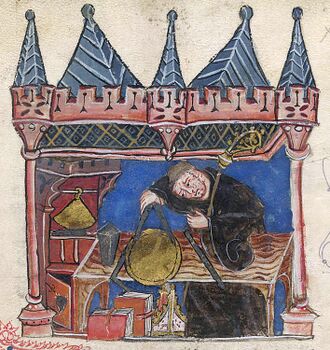
Cathedral chapters were expected to operate a school from the late 11th century, and the more lenient cathedral schools quickly marginalised the traditional monastic schools. Schools reaching the highest level of mastery within the disciplines they taught received the rank of studium generale, or university from the pope or the Holy Roman Emperor.[342][343] The new institutions of education encouraged scholarly discussions.[344] Debates between the realists and the nominalists over the concept of "universals" were especially heated. Philosophical discourse was stimulated by the rediscovery of Aristotle and his emphasis on empiricism and rationalism. Scholars such as Peter Abelard (d. 1142) and Peter Lombard (d. 1164) introduced Aristotelian logic into theology.[345] Scholasticism, the new method of intellectual discourse and pedagogy, required the study of authoritative texts, notably the Vulgate and patristic literature, but references to them could no more override rational argumentation.[346] Scholastic academics summarised their and other authors' views on specific subjects in comprehensive sentence collections known as summae, including the Summa Theologica by Thomas Aquinas (d. 1274).[347]
Chivalry and the ethos of courtly love developed in royal and noble courts. This culture was expressed in the vernacular languages rather than Latin, and comprised poems, stories, legends, and popular songs. Often the stories were written down in the chansons de geste, or "songs of great deeds", glorifying their male heroes' often brutal acts such as The Song of Roland, and The Poem of the Cid. In contrast, chivalric romance praised chaste love, while eroticism was mainly present in poems composed by troubadours.[348][349] Chivalric literature took inspiration from classical mythology, and also from the Celtic legends of the Arthurian cycle collected by Geoffrey of Monmouth (d. c. 1155).[350] Further featuring literary genres include spiritual autobiographies, chronicles, philosophical poems, and hymns.[note 32][351] Theatre developed in the guise of mystery plays performed in the vernacular, but comic farces, like those written by Adam de la Halle (d. 1287/88) also gained popularity.[352]
The discovery of a copy of the Corpus Juris Civilis in the 11th century paved the way for the systematic study of Roman law at Bologna. This led to the recording and standardisation of legal codes throughout Western Europe.[note 33] Around 1140, the monk Gratian (fl. 12th century), a teacher at Bologna, wrote what became the standard text of ecclesiastical law, or canon law—the Decretum Gratiani.[355] Among the results of the Greek and Islamic influence on this period in European history was the replacement of Roman numerals with the decimal positional number system and the invention of algebra, which allowed more advanced mathematics. Astronomy benefited from the translation of Ptolemy's Almagest from Greek into Latin in the late 12th century. Medicine was also studied, especially in southern Italy, where Islamic medicine influenced the school at Salerno.[356]
Architecture and arts
Encastellation continued, as more and more stone fortresses were built in regions where central authority was weak.[357] Many of them were motte-and-bailey structures, but Bergfriede, or tower castles, were preferred in Central Europe,[note 34] and the competing urban families built tall towers in Italian cities and towns.[note 35][360] The great pilgrimages entailed the construction of large churches along pilgrimage roads.[note 36] This led to the development of stone architecture that bears some resemblance to classical Roman building design, hence known as Romanasque. Romanesque buildings have massive stone walls, decorated with sculpture in relief, and are typically covered by barrel, groin or rib vaults.[362] Romanesque has various regional variants: in Provence, Corinthian columns betray the direct influence of the local Roman monuments; in Tuscany, stone arches were used as ornamental elements; and in Norway, dragon heads decorated the exterior of stave churches.[363] Some Serbian churches display Romanesque influence[note 37] but traditional Byzantine religious architecture remained dominant in the Balkans.[365]
Romanesque art, especially metalwork, was at its most sophisticated in Mosan art, in which distinct artistic personalities including Nicholas of Verdun (d. 1205) become apparent, and an almost classical style is seen in works such as a font at Liège.[366] Few wall-paintings survive although references to images abound in written sources. The employment of itinerant artists, and the use of sketches made of murals facilitated the transmission of artistic motifs over large territory.[note 38] Embroidery flourished as the churches and castles were decorated by tapestries, and clerical vestments were adorned by needlework images.[368]
Structural innovations introduced the development of the Gothic style from Romanesque. These included pointed arches for the reduction of lateral thrust, flying buttresses to reinforce the walls, and rib vaults to minimise their static importance. The new solutions allowed the extensive use of large stained glass windows.[369] The Gothic architecture emerged as a combination of all these during the reconstruction of the Saint-Denis Abbey near Paris under Abbot Suger (d. 1151).[370][371] The new style quickly spread and dominated religious architecture in much of Catholic Europe till the end of the Middle Ages.[note 39][374]
The practice of manuscript illumination gradually passed from monasteries to lay workshops, and the book of hours developed as a form of devotional book for lay-people.[375] Metalwork continued to be the most prestigious form of art, with Limoges enamel a popular and relatively affordable option.[376] In Italy the innovations of Cimabue and Duccio, followed by the Trecento master Giotto (d. 1337), greatly increased the sophistication and status of panel painting and fresco.[377] Increasing prosperity during the 12th century resulted in greater production of secular art; many carved ivory objects such as gaming pieces, combs, and small religious figures have survived.[378]
Late Middle Ages
Society and economy
Average annual temperature was declining from around 1200, introducing the gradual transition to the Little Ice Age. Climate anomalies caused agricultural crises, culminating in the Great Famine of 1315–17.[379] As the starving peasants slaughtered their draft animals, those who survived had to make extraordinary efforts to revive farming.[380] These troubles were followed in 1346 by the Black Death, a pandemic that spread throughout Europe, killing about one-third of the population in four years. As plague continued to strike Europe regularly until 1400, the total population reduced by about 50 percent.[note 40][381] The trauma of the plague led to savage pogroms against the Jews, and the self-mortification of the flagellants.[383] The peasants who survived the pandemic paid lower rents to the landlords but demand for agricultural products declined, and the lower prices barely covered their costs. Urban workers received higher salaries but they were heavily taxed. Occasionally, the governments tried to fix rural rents at a high level, or to keep urban salaries low, which provoked popular uprisings, including the Jacquerie in France, the Peasants' Revolt in England, and the Ciompi Revolt in Florence.[384]
Labor services the peasants owed for their land tenure were often changed into cash rents, providing the landlords with a stable source of income. Landlords joined to extort privileges from their governments but royal administration also started to protect the interests of the poor.[385] From the early 14th century, serfdom was officially abolished in many places,[386] although in other regions, mainly in Central and Eastern Europe, it was imposed on tenants who had previously been free.[387] The rise of banking continued, fuelled partly by the crossborder movement of papal revenues with the mediation of large merchant houses. These also loaned money to warring royalty, at great risk, as some were bankrupted when kings defaulted on their loans.[note 41][389]
Private feuds were almost permanent in politically fragmented regions, and local skirmishes often escalated into full-scale warfare.[390] Reissen, or crusading tours in the Baltic region, became a fashionable form of warring for Catholic aristocrats.[391] Conflicts between ethnic groups became polarised, and local statutes were issued to prohibit intermarriages and limit membership in guilds along ethnic lines.[note 42][393]
The Jewish communities were permanently expelled from France, and at least provisionally from most German cities and principalities. In contrast, the Hungarian and Polish rulers encouraged the Jewish moneylenders' immigration.[394] Massive pogroms led to the mass conversion of Spanish Jewry in 1391. As the "New Christians" were suspected of heresy, the Spanish Inquisition was established to inspect their faith. The Jews who refused to convert were exiled from Spain in 1492, and from Portugal in 1497. Most Spanish Jews left for the Ottoman Empire.[395][396]
State resurgence
Although the growth of central governments continued, still more than 500 autonomous polities existed at the end of the period.[397] Taxation quickly expanded which contributed to the development of self-conscious communities of taxpayers, eager to protect their common interests both at central and local levels.[398] Legal procedures improved as discretionary justice, previously dispensed by kings and their retainers, was delegated to professional lawyers.[399] Commoners could approach their kings but from the end of the period flattering courtiers and royal propaganda emphasised the distance between the monarchs and their subjects.[400] Successful dynasties reigned over several states mainly in close cooperation with local elites but could not freely redistribute resources among their realms.[note 43][399]
In Germany, the elected emperors were no more than supreme arbitrators even if they had a significant power base in their hereditary lands.[note 44][402][403] The emperors' authority was even more limited in Italy where Florence, Milan, and Venice exploited the power vacuum to expand.[404] The centuries-old rivalry between England and France escaleted into the Hundred Years' War when Edward III (r. 1327–77) laid claim to the French throne in 1337.[405][406] The English won the battles of Crécy and Poitiers, captured the city of Calais, and won control of an enlarged Gascony by 1360. French aristocrats' feuds escalated into a civil war, allowing Henry V of England (r. 1413–22) to seize much of France.[407][408] The unconquered French regions put up a strong resistance, boosted by the visions of a peasant girl Joan of Arc (d. 1431), and Charles VII of France (r. 1422–61) expelled the English from the country except for Calais by 1453.[409][410] England went on to suffer a long civil war known as the Wars of the Roses, which ended after Richard III (r. 1483–85) died fighting at Bosworth, and his opponent Henry Tudor consolidated power as Henry VII (r. 1485–1509).[411] The wars mainly prevented the English to expand in the British Isles, but royal power remained weak in Scotland, and much of Ireland was ruled by feuding local lords.[412][413]
Succession troubles were not uncommon in the Iberian kingdoms, as intermarriages between the royal houses created conflicting claims to the thrones, and royal bastards could successfully claim their father's inheritance.[414][415] Portugal opened a new theater of anti-Muslim warfare in Morocco by seizing Ceuta in 1415.[416] Aragon and Castile were riven by conflicts between magnate factions or over the limits of royal government but the Castilian Isabella I (r. 1474–1504) and her Aragonese husband Ferdinand II (r. 1479–1516) reinforced royal power.[417] They completed the Reconquista by conquering Granada in 1492.[418]
The idea of elective kingship revived in the Central European and Scandinavian monarchies for various reasons, including the aristocrats' aversion to foreign influence.[419][420] Royal power was restored in Poland early in the 14th century, in a period when the Teutonic Knights' expansion intensified. The Knights primarily targeted Lithuania, a loose confederation of mainly pagan Lithuanian chieftains and Orthodox Rus' principalities. The common enemy prompted a lasting Polish–Lithuanian union, sealed by the marriage of the Lithuanian grand duke Jogaila (r. 1377–1434) with the Polish queen Jadwiga (r. 1384–99),[note 45] and the Lithuanians' conversion to Catholicism.[422][423] In Scandinavia, Margaret I of Denmark (r. 1387–1412) consolidated Denmark, Norway, and Sweden in the Union of Kalmar in 1397 but only the Danish–Norwegian union proved lasting.[note 46][426]
After Polish, Hungarian, and Lithuanian invasions, and succession crises undermined the Golden Horde's power in the 14th century, the princes of Muscovy began annexing the Rus' principalities often in competition with Lithuania.[note 47] Under Grand Prince Ivan III (r. 1462–1505), the conquest of the great trading cities of Novgorod and Tver completed Muscovy's dominance in the northeast.[429][430] In southeastern Europe, two small Vlach principalities emerged, Wallachia and Moldavia; their rulers mainly accepted the suzerainty of the Hungarian or Polish kings.[431]
Collapse of Byzantium and rise of the Ottomans
Facing financial crises and threats from the west, the restored Byzantine Empire was unable to prevent the Turks' expansion in Anatolia. Revolts by Catalan mercenaries and recurring civil wars further weakened the empire,[note 48] allowing the Ottoman Turks to establish a strategic bridgehead at Gallipoli in Europe in 1354.[433][434] Within a century, the Ottomans reduced the competing southeastern European kingdoms, principalities and lordships to tributary states.[435][436] International coalitions, such as the Crusades of Nicopolis (1396) and Varna (1444), could not stop their advance.[437] The last Byzantine emperor Constantine XI (r. 1449–53) died fighting during the conquest of Constantinople by Sultan Mehmed II (r. 1451–81).[438] Talented military commanders could repel individual Ottoman attacks[note 49] but by the end of the century the Ottomans conquered almost the whole Balkans: Bulgaria was fully occupied in 1396, Serbia in 1459, Byzantine Greece in 1460, Bosnia in 1463, and the Ottomans broke all Albanian lords' resistance by 1488.[440] The Ottoman sultans ruled a highly centralised state, often appointing slaves to the highest offices. From the late 15th century, the sultans murdered their brothers to avoid succession crises.[441]
Controversy within the Church
As prolonged papal elections and conflicts with the Roman aristocracy had undermined papal authority in Italy, the seat of the papacy was moved to the city of Avignon in 1309, introducing the period of the Avignon Papacy. The French king Philip IV (r. 1285–1314) brought the wealthy Knights Templar to court on the false charges of heresy and deviance, and Pope Clement V (1305–14) could not prevent their suppression in 1312.[442][443] Under popular pressure, the papal seat was returned to Rome in 1377, but disputes within the leadership of the Church led to the Great Schism, with two and later three rival lines of popes, each supported by several states. The schism was removed at the Council of Constance, with the resignation of one of the popes and the deposition of his two rivals, which paved the way for the election of an Italian cardinal as Pope Martin V (1417–31).[444][445]
Theological debates intensified.[446] John Wycliffe (d. 1384), an English theologian, criticised popular acts of devotion, such as pilgrimages, and challenged the Catholic doctrine on the Eucharist.[447] His teachings influenced two major movements condemned as heretics by the official Church: Lollardy in England, and Hussitism in Bohemia.[448] The Bohemian movement initiated with the teaching of the Czech theologian Jan Hus (d. 1415) who was burned at the stake at Constance. Hussitism, although the target of anti-heretic crusades, survived as an officially recognised denomination in Bohemia.[note 50][450][451] In the hope of western support against the Ottomans, Byzantine church leaders submitted themselves to the papacy at the Council of Florence in 1438–39, but most Orthodox believers rejected papal supremacy, and those who supported the church union died in exile.[note 51][453]
Mysticism and devotional literature flourished.[454] Meister Eckhart (d. 1327), a skilful critic of Aquinas, urged the faithful to focus on their inner divine core for perfection. Although his works were censured for heresy, his sermons survived in copies, also read by the Protestant reformator Martin Luther (d. 1546).[455] The most characteristic late medieval reform movement, the Devotio Moderna put a special emphasis on lay piety, community experience and personal faith.[456] In the Orthodox world, the Athonite monks Gregory of Sinai (d. 1346) and Gregory Palamas (d. 1359) promoted a form of meditative prayers known as Hesychasm.[457] A general fear of evil practices led to the first witch trials around 1450, but a popular handbook, the Malleus Maleficarum ('Hammer of the Witches'), laid the groundwork for hysterical early modern witch hunts.[458]
Scholars, intellectuals, and exploration
Prominent late medieval philosophers departed from Aristotelian logic. Among them, William of Ockham (d. c. 1348) concluded that natural philosophy could not prove God's existence. Under his influence, most scholars who researched subjects yielding verifiable conclusions such as mathematics or physics no more analysed theological issues.[459] In contrast, Marsilius of Padua (d. 1342) gained inspiration from Aristotle to argue in favor of the communities' right to regulate their life and control the clergy.[460] The level of literacy improved as new schools and universities were established all over Europe.[note 52] These were often sponsored by urban authorities or rich individuals.[463][464] The invention of printing press with movable type simplified the mass publication of books at a reasonable price, and the competition between publishing houses contributed to the quick spread of news and new ideas.[465]
The poetry of Dante (d. 1321) and the prose of Boccaccio (d. 1375), both from Florence, indicate that the Tuscan dialect of Italian matured into a literary language on a par with Latin. English reached the same level with the Canterbury Tales, written by Geoffrey Chaucer (d. 1400). In France, theoretical discussions about chivalric literature led to the standardisation of French. Christine de Pizan (d. c. 1430), a sharp critic of chivalric romances for their prejudice against women, authored a feminist utopia, The Book of the City of Ladies in French.[466]
Several factors, primarily a growing demand for gold and the European merchants' eagerness to avoid custom payments prompted the search for a direct maritime route towards India along the African coasts. Initially, the Portuguese assumed the leadership of the explorations: Dinis Dias landed at Cap Verde in 1444, Bartolomeu Dias (d. 1500) sailed as far as Cape of Good Hope in 1486, and Vasco da Gama (d. 1524) reached India in 1498. After visiting the African slave markets, the Portuguese became deeply involved in slave trade towards Europe and the Muslim world.[note 53][469] Christopher Colombus proposed a westward alternative route to India. He gained Isabella of Castile's support for his voyage of exploration that led to his discovery of the Americas in 1492.[470][471]
Technological and military developments
In cloth production, the second main employer after agriculture, the invention of treadle-wheel improved productivity,[472] and the increased usage of sheep with long-fibred wool allowed a stronger thread to be spun.[255] From the 14th century, the use of buttons as closures for garments enabled better fit.[473] Popular tailoring designs were quickly spread by pedlars, and trends in fashion were dictated by the style of the Burgundian dukes' court in much of 15th-century Europe.[474] In metalworking, the blast furnace increased the quantity of iron produced, also improving its quality.[475] The first patent law in 1447 in Venice granted a ten-year monopoly to inventors for their inventions.[476]
As increased tax revenues allowed the employment of mercenaries in growing numbers,[477] wars were mainly fought by professional soldiers almost all over Europe from the mid-14th century.[478] Initially, mercenaries were hired for periods of war but a standing army was created in France in the late 1440s.[479] From around 1438, child tribute from the Christian population supplied the Ottoman army with professional foot soldiers known as Jannisaries.[480] In Bohemia, religious enthusiasm, stern discipline and the use of wagon forts were the key factors in the Hussites' victories.[481] The earliest references to cannons were recorded in the early 14th century; the use of cheap handguns quickly spread from around 1360.[482]
Art and architecture
The Late Middle Ages in Europe as a whole correspond to the Trecento and Early Renaissance cultural periods in Italy. Northern Europe and Spain continued to use Gothic styles, which became increasingly elaborate in the 15th century, until almost the end of the period. International Gothic was a courtly style that reached much of Europe in the decades around 1400, producing masterpieces such as the Très Riches Heures du Duc de Berry.[483] All over Europe, secular art continued to increase in quantity and quality, and in the 15th century, the mercantile classes of Italy and Flanders became important patrons, commissioning small portraits as well as a growing range of luxury items such as jewellery, ivory caskets, cassone chests, and maiolica pottery. Although royalty owned huge collections of plate, little survives except for the Royal Gold Cup.[484] Italian silk manufacture developed, so that Western churches and elites no longer needed to rely on imports from Byzantium or the Islamic world. In France and Flanders tapestry weaving of sets like The Lady and the Unicorn became a major luxury industry.[485]
The large external sculptural schemes of Early Gothic churches gave way to more sculpture inside the building, as tombs became more elaborate and other features such as pulpits were sometimes lavishly carved, as in the Pulpit by Giovanni Pisano in Sant'Andrea. Painted or carved wooden relief altarpieces became common, especially as churches created many side-chapels. Early Netherlandish paintings by artists such as Jan van Eyck (d. 1441) and Rogier van der Weyden (d. 1464) rivalled that of Italy, as did northern illuminated manuscripts, which in the 15th century began to be collected on a large scale by secular elites, who also commissioned secular books, especially histories.[citation needed] From about 1450, printed books rapidly became popular, though still expensive. There were around 30,000 different editions of incunabula, or works printed before 1500,[486][|permanent dead link|dead link}}] by which time illuminated manuscripts were commissioned only by royalty and a few others. Very small woodcuts, nearly all religious, were affordable even by peasants in parts of Northern Europe from the middle of the 15th century.[failed verification] More expensive engravings supplied a wealthier market with a variety of images.[failed verification][487]
Modern perceptions
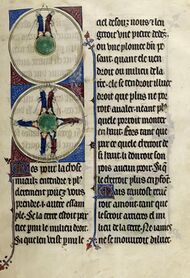
The medieval period is frequently caricatured as a "time of barbarism, ignorance, and superstition" that placed "religious authority above personal experience and rational activity" (David Lindberg).[488] This is a legacy from both the Renaissance and Enlightenment when scholars favourably contrasted their intellectual cultures with those of the medieval period. Renaissance scholars saw the Middle Ages as a period of decline from the high culture and civilisation of the Classical world. Enlightenment scholars saw reason as superior to faith, and thus viewed the Middle Ages as a time of ignorance and superstition.[12]
Others argue that reason was generally held in high regard during the Middle Ages. Science historian Edward Grant writes, "If revolutionary rational thoughts were expressed in the Age of Reason, they were only made possible because of the long medieval tradition that established the use of reason as one of the most important of human activities".[489] Also, contrary to common belief, Lindberg writes, "The late medieval scholar rarely experienced the coercive power of the Church and would have regarded himself as free (particularly in the natural sciences) to follow reason and observation wherever they led."[490]
The caricature of the period is also reflected in some more specific notions. One misconception, first propagated in the 19th century, is that all people in the Middle Ages believed that the Earth was flat.[491] This is untrue, as lecturers in the medieval universities commonly argued that evidence showed the Earth was a sphere.[492]
Notes
- ↑ The term is sometimes written as mediaeval or mediæval.[4][5]
- ↑ The commanders of the Roman military in the area appear to have taken food and other supplies intended to be given to the Goths and instead sold them to the Goths. The revolt was triggered when one of the Roman military commanders attempted to take the Gothic leaders hostage but failed to secure all of them.[42]
- ↑ An alternative date of 480 is sometimes given, as that was the year Romulus Augustulus' predecessor Julius Nepos (r. 474–75) died; Nepos had continued to assert that he was the Western emperor while holding onto Dalmatia.[51]
- ↑ Brittany takes its name from this settlement by Britons.[63]
- ↑ Among the powerful women, the Arian queen Goiswintha (d. 589) was a vehement but unsuccessful opponent of the Visigoth's conversion to Catholicism, and the Frankish queen Brunhilda of Austrasia (d. 613) was torn to pieces by horses at the age of 70.[80]
- ↑ Rome, for instance, shrank from a population of hundreds of thousands to around 30,000 by the end of the 6th century.[89]
- ↑ Examples include Liudewit (d. 823) who ruled the lands along the Sava river, and Pribina (d. 861) whose domains were located in the March of Pannonia.[133]
- ↑ The Vita Karoli Magni ('Life of Charlemagne') by Einhard (d. 840) is a prominent example of original historical works.[138]
- ↑ Hugh Capet was a grandson of King Odo's brother Robert I, himself also a king of West Francia (r. 922–23).[146]
- ↑ Examples include a 4th-century basilica uncovered under the Barcelona Cathedral, the five-aisled Cathedral of Saint Étienne in Paris, and the huge Basilica of Sant'Apollinare in Classe in Ravenna.[171]
- ↑ Later Roman ornaments decorate Charlemagne's palace at Aachen, the Carolingian royal palace at Ingelheim, and the Asturian kings' palace at Oviedo.[176]
- ↑ An early example of stone fortresses is the residential keep built by Theobald I, Count of Blois (d. 975) around 950.[177]
- ↑ As illuminated books were flowing from the British Isles to Francia, the Insular style had a marked impact on Frankish art.[182]
- ↑ Under the Macedonian emperors, the old churches were redecorated, and the newly built churches, like the Daphni Monastery in Greece, were embellished with mosaics and icons. Richly decorated ivory panels, such as the Harbaville Triptych, show the renewal of ivory carving during the same period.[185]
- ↑ Examples include vivid caricatures in the Utrecht Psalter, and more naturalistic miniatures in the Gospel Book of Charlemagne.[188]
- ↑ In France, Germany, and the Low Countries there was a further type of "noble", the ministerialis, who were in effect unfree knights. They descended from serfs who had served as warriors or government officials, which increased status allowed their descendants to hold fiefs as well as become knights while still being technically serfs.[217]
- ↑ For instance, the Anglo-Norman aristocrat Robert Bruce (d. 1141) received the Lordship of Annandale in southern Scotland from King David I (r. 1124–53), whereas John de Courcy (d. 1219), also an Anglo-Norman knight, seized Ulaid in Ireland by force.[220]
- ↑ Often facing misogyny, Hildegard endorsed the traditional view of the women's fragility in her early works but later she emphasised that men and women were dependent on each other. Although a nun, she provided the first description of female orgasm.[234]
- ↑ These two groups—Germans and Italians—took different approaches to their trading arrangements. Most German cities co-operated when dealing with the northern rulers; in contrast with the Italian city-states who engaged in internecine strife. Conflicts between Italian, Catalan and Provençal merchant communities culminated in the War of Saint Sabas in the Levant in 1257.[244]
- ↑ The Jews were required to wear a distinctive badge on their cloths and to live in their own districts in the towns.[250]
- ↑ It had spread in Northern Europe by 1000, and had reached Poland by the 12th century.[259]
- ↑ Crossbows are slow to reload, which limits their use on open battlefields. In sieges the slowness is not as big a disadvantage, as the crossbowman can hide behind fortifications while reloading.[263]
- ↑ The Mongols were reportedly the first to use gunpowder in Europe in the mid-13th century.[265]
- ↑ Most compromise was based on a distinction between a prelate's spiritual and temporal responsibilities. This allowed the bishops and abbots to swear an oath of fealty to the emperor or king in return for their investment in the possessions of bishoprics and abbeys without formally sanctioning the monarch's claim to control their election.[271]
- ↑ The formation of the idea is mainly attributed to the early modern philosophers Jean Bodin (d. 1596) and Thomas Hobbes (d. 1679) but the concept developed during the conflicts between the emperors and the papacy. Already in 1202, a papal decretal stated that "a king is an emperor in his kingdom", expressing that kings were not subject to the emperor's authority, and implying the equal status of secular monarchs.[281]
- ↑ Urraca (r. 1109–26) reigned in León and Castile, Petronilla (r. 1137–62) in Aragón, and Constance (r. 1194–98) in Sicily.[284]
- ↑ Frederick II had a harem, was dressed in Arab-style garments, and wore a mantle decorated with verses from the Quran during his imperial coronation in Rome.[296]
- ↑ Henry inherited Anjou from his father, and seized Aquitaine by marrying the heiress Eleanor (r. 1137–1204) just months after her marriage to Louis VII of France (r. 1137–80) had been annulled.[303]
- ↑ Prince Alexander Nevsky (d. 1263) made four visits at Sarai to gain the Khans' favor. He overcame his rivals with Mongol assistance, crushed an anti-Mongol riot in Novgorod, and received a grant of tax exemption for the Orthodox Church.[323]
- ↑ After the fall of Constantinople to the crusaders, three Byzantine successor states emerged: Epirus in northern Greece and Albania, Nicaea in western Anatolia, and Trebizond in northeastern Anatolia. Michael VIII had ruled Nicaea before seizing Constantinople.[334]
- ↑ Those who decided to participate in a crusade took an oath and placed the mark of the cross on their cloths. The crusaders enjoyed privileges, including a moratorium on debts, but those who failed to fulfil the crusader oath faced infamy or excommunication.[337]
- ↑ Examples include the spiritual works of Guibert of Nogent (d. c. 1125), the lyric correspondence between Abelard and his former lover Héloïse (d. c. 1164), The Two Cities by Otto of Freising (d. 1158), the poems of Alan of Lille (d. 1202/03), and Stabat Mater, a hymn to Virgin Mary.[351]
- ↑ The earliest law codes include the Constitutions of Melfi in Sicily, the Siete Partidas ('Seven Parts') in Castile, and the Landslov ('Code of the Realm') in Norway.[353] In contrast, the common law system in England developed through the adoption of principles and procedures such as trial by jury by royal courts.[354]
- ↑ With its central tower, and outer walls built on top of a rocky hill, Trifels Castle is a representative monument of Bergfriede in Germany.[358]
- ↑ Reportedly, the tall torri ('towers') made some Italian towns look like brick and stone forests. The small Tuscan town of San Gimignano is still a good example although only few of the family towers have survived.[359]
- ↑ The Basilica of Saint-Sernin in the city of Toulouse is one of the earliest pilgrimage churches on the Camino de Santiago ('Way of Saint James').[361]
- ↑ The Church of the Virgin in the Studenica Monastery well illustrates the blending of Byzantine and Romanesque traditions in Serbia. Its west portal with its tympanum was completed by southern Italian builders in the late 12th century.[364]
- ↑ Artistic motifs could be disseminated over huge areas through the copying and recopying of sketches, as it is demonstrated by the similarity between wall-paintings depicting the life of the Virgin in the St Mark's Basilica in Venice and in the Cathedral of Christ's Transfiguration in the Rus' city of Pskov.[367]
- ↑ Prominent examples include the cathedrals at Chartres and Reims, and the Sainte-Chapelle in France, Salisbury Cathedral in England, Cologne Cathedral in Germany, Milan Cathedral in Italy, and the Saint Vitus Cathedral in Prague.[372][373]
- ↑ Towns were especially hard-hit because of their crowded conditions.[381] One town, Lübeck in Germany, lost 90 per cent of its population to the Black Death.[382]
- ↑ As happened with the Bardi and Peruzzi firms in the 1340s when King Edward III of England repudiated their loans to him.[388]
- ↑ In Bohemia, a mid-14th-century Czech treatise accused the local German artisans of plotting to keep prices high. In 1392, the guild of the bakers in the city of Riga excluded those who married a non-German women. In the town of Limerick, "No one of Irish blood or birth" could hold offices or be hired as apprentices.[392]
- ↑ The most successful dynasties were the Luxembourgs, Habsburgs, and Jagiellonians in Central and Eastern Europe, the Trastámaras in the Mediterranean, and the Valois of Burgundy.[399]
- ↑ The Luxemburgs held the Lands of the Bohemian Crown, the Habsburg were expanding in the region of Austria, and the Wittelsbachs ruled Bavaria and the Palatinate.[401]
- ↑ Both Jadwiga and her elder sister the Hungarian queen Mary (r. 1382–95) had been crowned "king" to demonstrate that they were queens regnant. Jogaila ruled as Władysław II in Poland (r. 1386–1434).[421]
- ↑ Although one of the most successful queens of the period, Margaret mainly ruled along with her young male relatives, first with her underage son, then with her young nephew. The Swedes first left the Kalmar Union in 1448.[424][425]
- ↑ Initially a tiny principality, Muscovy gained strength against its more powerful neighbors with the Mongol khans' support. From the 1320s, Moscow was the seat of the head of the Orthodox Church in the Rus' principalities.[427][428]
- ↑ The first civil war broke out when Emperor Andronikos II (r. 1282–1328) disinherited his grandson Andronikos III (r. 1328–41) for fratricide. The second civil war was fought over the regency for Andronikos III's underage son John V (r. 1341–90) between the powerful aristocrat John Kantakouzenos (d. 1383) and his opponents. Kantakouzenos was crowned co-emperor as John VI (r. 1347–54) but his conflict with John V caused the third civil war.[432]
- ↑ Skanderbeg (d. 1468) resisted Ottoman conquest for more than two decades at the head of a league of Albanian lords; John Hunyadi (d. 1456) defeated the Ottomans at Belgrade, and the Moldavian prince Stephen the Great (r. 1457–1504) at Vaslui.[439]
- ↑ The Bohemian Diet elected the moderate Hussite Czech aristocrat George of Poděbrady (r. 1457–71) king which provided an excuse for the Hungarian king Matthias Corvinus (r. 1458–90) to conquer parts of the Czech lands. Poděbrady was succeeded by the Catholic Polish prince Vladislaus II (r. 1471–1516) but the Diet enacted the Czechs' right to freely choose between Hussitism and Catholicism in 1485.[449]
- ↑ One of the main supporters of the church union, the erudite Basilios Bessarion (d. 1472) aroused the Italian scholars' interest in Greek studies during his exile.[452]
- ↑ Although medieval documents often described people as literatus or illiteratus, estimations of literacy rate are uncertain because these terms are ambigious.[461] One estimate gave a literacy rate of ten per cent of males and one per cent of females in 1500.[462]
- ↑ The Portuguese prince Henry the Navigator (d. 1460) presided over an auction of African slaves at Lagos already in 1444.[467] He is often but not universally described as the prime mover in the Portuguese explorations.[468]
Citations
- ↑ Power 2006, p. 3.
- ↑ 2.0 2.1 Hankins 2001, pp. xvii–xviii.
- ↑ Murray 2004, p. 4.
- ↑ 4.0 4.1 Hornby 2005, p. 955.
- ↑ 5.0 5.1 Onions, Friedrichsen & Burchfield 1994, p. 566.
- ↑ Mommsen 1942, p. 238.
- ↑ Mommsen 1942, pp. 228–238.
- ↑ Fried 2015, p. viii.
- ↑ Wickham 2016, p. 1.
- ↑ 10.0 10.1 Rubin 2014, p. 1.
- ↑ Rubin 2014, p. 5.
- ↑ 12.0 12.1 Davies 1996, pp. 291–293.
- ↑ Power 2006, p. 304.
- ↑ Mommsen 1942, p. 226.
- ↑ Holmes & Standen 2018, pp. 15–16.
- ↑ Heng 2021, pp. 18–24.
- ↑ Arnold 2021, pp. 26–27.
- ↑ Arnold 2021, pp. 37, 40.
- ↑ Arnold 2021, pp. 44–45.
- ↑ Curta 2019, pp. 17–23.
- ↑ Curta 2019, pp. 28–29.
- ↑ Wickham 2009, p. 204.
- ↑ Arnold 2021, pp. 47–50.
- ↑ Heather 2006, pp. 10–14.
- ↑ Collins 2010, pp. 3–6.
- ↑ 26.0 26.1 Heather 2006, p. 111.
- ↑ 27.0 27.1 Brown 1989, pp. 24–25.
- ↑ Collins 2010, pp. 8–11.
- ↑ Collins 2010, pp. 23–24.
- ↑ Brown 1989, p. 34.
- ↑ Brown 1989, pp. 65–68, 82–94.
- ↑ Backman 2022, pp. 43–45.
- ↑ Collins 2010, pp. 60–75.
- ↑ Chazan 2006, p. 35.
- ↑ Nees 2002, pp. 32–36.
- ↑ Kitzinger 1969, pp. 1–15.
- ↑ Nees 2002, pp. 52–56.
- ↑ Stalley 1999, pp. 21–23.
- ↑ Nees 2002, pp. 156–157.
- ↑ Collins 2010, pp. 31–33.
- ↑ 41.0 41.1 Brown 1989, pp. 122–124.
- ↑ Collins 2010, p. 51.
- ↑ Heather 2006, pp. 145–180.
- ↑ Heather 2006, p. 219.
- ↑ Collins 2010, pp. 59–60.
- ↑ Heather 2006, p. 417.
- ↑ Collins 2010, p. 80.
- ↑ James 2009, pp. 67–69.
- ↑ Wickham 2009, p. 79.
- ↑ Wickham 2009, pp. 96–97.
- ↑ 51.0 51.1 Wickham 2009, p. 86.
- ↑ Collins 2010, pp. 116–134.
- ↑ Wickham 2009, pp. 98–101.
- ↑ Collins 2010, pp. 99–100.
- ↑ Rubin 2014, pp. 11–13.
- ↑ Wickham 2009, pp. 102–103.
- ↑ Wickham 2009, pp. 156–159.
- ↑ Wickham 2009, pp. 164–165.
- ↑ James 2009, pp. 82–94.
- ↑ James 2009, pp. 77–78.
- ↑ James 2009, pp. 79–81.
- ↑ Brown 1989, p. 124.
- ↑ 63.0 63.1 James 2009, p. 78.
- ↑ James 2009, p. 77.
- ↑ Collins 2010, pp. 203–209.
- ↑ Curta 2019, pp. 51–59.
- ↑ Curta 2019, pp. 71–77.
- ↑ Davies 1996, pp. 235–238.
- ↑ Wickham 2009, pp. 81–82.
- ↑ Ringrose 2016, pp. 374–375.
- ↑ Wickham 2009, p. 83.
- ↑ Backman 2022, pp. 130–131.
- ↑ Brown 1989, pp. 150–156.
- ↑ Brown 2001, pp. 8–10.
- ↑ Collins 2010, pp. 138–141.
- ↑ Brown 1989, pp. 174–175.
- ↑ Brown 2001, pp. 45–49.
- ↑ Wickham 2009, pp. 189–193.
- ↑ Wickham 2009, pp. 195–199.
- ↑ Wickham 2009, pp. 116, 197.
- ↑ Wickham 2009, pp. 116, 195–197.
- ↑ Backman 2022, p. 120.
- ↑ Bitel 2002, pp. 180–182.
- ↑ Wickham 2009, pp. 205–210.
- ↑ Wickham 2009, pp. 211–212.
- ↑ Wickham 2009, p. 215.
- ↑ McCormick 2010, pp. 733–744.
- ↑ Backman 2022, pp. 119–120.
- ↑ Brown 2001, p. 26.
- ↑ Brown 2001, pp. 24–26.
- ↑ Gies & Gies 1973, pp. 3–4.
- ↑ Chazan 2006, pp. 77–78, 90–93, 116–117.
- ↑ Chazan 2006, p. 92.
- ↑ McCormick 2010, p. 649.
- ↑ Collins 2010, pp. 136, 141–142.
- ↑ Collins 2010, pp. 143–150, 160, 226.
- ↑ Collins 2010, pp. 376–377.
- ↑ Brown 2001, p. 15.
- ↑ Collins 2010, pp. 373–375.
- ↑ Ringrose 2016, pp. 372–373.
- ↑ Wickham 2009, pp. 218–219.
- ↑ Collins 2010, pp. 347–349.
- ↑ Naismith 2023, pp. 15, 227–228, 236–237, 268–271.
- ↑ Collins 2010, p. 354.
- ↑ McCormick 2010, pp. 753–754, 763.
- ↑ McCormick 2010, pp. 708–733.
- ↑ McCormick 2010, pp. 791–792.
- ↑ McCormick 2010, pp. 670–677.
- ↑ 109.0 109.1 Brown 2001, p. 41.
- ↑ Collins 2010, pp. 220–233.
- ↑ Brown 2001, pp. 45–46.
- ↑ Hamilton 2003, p. 35.
- ↑ Wickham 2009, pp. 170–172.
- ↑ Colish 2002, pp. 62–63.
- ↑ Bitel 2002, pp. 127–133.
- ↑ Curta 2019, pp. 527–530.
- ↑ Collins 2010, pp. 75–77.
- ↑ Collins 2010, pp. 239–240.
- ↑ Curta 2019, pp. 322, 495.
- ↑ Wickham 2009, pp. 185–187.
- ↑ Hamilton 2003, pp. 43–44.
- ↑ Colish 2002, pp. 63–65.
- ↑ Bitel 2002, pp. 285–286.
- ↑ Colish 2002, p. 163.
- ↑ Curta 2019, pp. 183–189, 209–213, 219–220.
- ↑ Backman 2022, pp. 214–216.
- ↑ Hamilton 2003, p. 45.
- ↑ Barber 2004, p. 87.
- ↑ Backman 2022, pp. 150–154.
- ↑ Collins 2010, pp. 276–279.
- ↑ Brown 2001, pp. 97–99.
- ↑ Collins 2010, pp. 280–288.
- ↑ Curta 2019, pp. 105–110.
- ↑ Curta 2019, pp. 103–110.
- ↑ Backman 2022, pp. 159–162.
- ↑ Davies 1996, p. 302.
- ↑ Collins 2010, p. 306.
- ↑ Colish 2002, p. 69.
- ↑ Colish 2002, pp. 66–70.
- ↑ Collins 2010, pp. 318–331.
- ↑ Wickham 2009, pp. xxvi–xxvii, 396.
- ↑ Backman 2022, pp. 186–189.
- ↑ Collins 2010, p. 337.
- ↑ Wickham 2009, pp. 401–403.
- ↑ Backman 2022, p. 254.
- ↑ 146.0 146.1 Collins 2010, pp. 341–342.
- ↑ Wickham 2009, pp. 439–444.
- ↑ 148.0 148.1 Wickham 2009, pp. 488–489.
- ↑ Backman 2022, pp. 191–199.
- ↑ Collins 2010, pp. 394–395.
- ↑ Collins 2010, pp. 350, 365.
- ↑ Backman 2022, p. 196.
- ↑ Collins 2010, pp. 362–363.
- ↑ Collins 2010, p. 368.
- ↑ Wickham 2009, p. 169.
- ↑ Collins 2010, pp. 394–411.
- ↑ Backman 2022, pp. 255–257.
- ↑ Collins 2010, pp. 376–386.
- ↑ Wickham 2009, p. 500.
- ↑ Curta 2019, pp. 131–134, 141–142.
- ↑ Curta 2019, pp. 143–151.
- ↑ Collins 2010, pp. 366–370.
- ↑ Wickham 2009, pp. 476–477.
- ↑ Davies 1996, pp. 318–320.
- ↑ Davies 1996, pp. 321–326.
- ↑ Curta 2019, pp. 239–248.
- ↑ Curta 2019, pp. 391–400.
- ↑ Curta 2019, pp. 343–347.
- ↑ Barber 2004, p. 334.
- ↑ Curta 2019, pp. 289–300.
- ↑ 171.0 171.1 Stalley 1999, pp. 28–29.
- ↑ Wickham 2009, pp. 232–233.
- ↑ Stalley 1999, pp. 21–44.
- ↑ Stalley 1999, pp. 43–44.
- ↑ Adams 2011, p. 172.
- ↑ 176.0 176.1 Stalley 1999, pp. 96–97.
- ↑ Stalley 1999, pp. 88–89.
- ↑ Stalley 1999, pp. 83–90.
- ↑ Henderson 1993, pp. 35–40.
- ↑ Nees 2002, pp. 104–105.
- ↑ Henderson 1993, pp. 47–57.
- ↑ Henderson 1993, pp. 63–64.
- ↑ Benton 2002, pp. 41–42.
- ↑ Kitzinger 1969, pp. 22–28.
- ↑ Benton 2002, pp. 36–37.
- ↑ Benton 2002, pp. 32–38.
- ↑ Kitzinger 1969, pp. 40–41.
- ↑ 188.0 188.1 Benton 2002, pp. 47–49.
- ↑ Lasko 1972, pp. 16–18.
- ↑ Henderson 1993, pp. 233–238.
- ↑ Kitzinger 1969, pp. 60–77.
- ↑ Nicolle 1996, pp. 28–29.
- ↑ Nicolle 1996, pp. 30–31.
- ↑ Curta 2019, p. 52.
- ↑ Nicolle 1996, p. 41.
- ↑ Nicolle 1996, pp. 34, 39.
- ↑ Nicolle 1996, pp. 58, 76.
- ↑ Nicolle 1996, pp. 59, 67.
- ↑ 199.0 199.1 Nicolle 1996, p. 80.
- ↑ Nicolle 1996, pp. 41, 88–91.
- ↑ Ellenblum 2012, pp. 3–11.
- ↑ 202.0 202.1 Jordan 2002, pp. 5–10.
- ↑ Backman 2022, p. 221.
- ↑ Singman 1999, pp. 6, 11, 171.
- ↑ Backman 2022, p. 220.
- ↑ Backman 2022, pp. 247–249.
- ↑ Singman 1999, pp. 4–6.
- ↑ Singman 1999, p. 6.
- ↑ Curta 2019, p. 467.
- ↑ Backman 2022, pp. 220–221.
- ↑ Backman 2022, pp. 231–232.
- ↑ Jordan 2002, pp. 10–12.
- ↑ Backman 2022, pp. 221–222.
- ↑ Bartlett 1994, pp. 111–123.
- ↑ Singman 1999, p. 2.
- ↑ Barber 2004, pp. 36–37.
- ↑ Singman 1999, p. 8.
- ↑ Singman 1999, p. 3.
- ↑ Barber 2004, p. 40.
- ↑ Bartlett 1994, pp. 32, 79.
- ↑ Bartlett 1994, pp. 24–39.
- ↑ Singman 1999, p. 11.
- ↑ Thomson 1998, p. 87.
- ↑ Singman 1999, pp. 11–12.
- ↑ Backman 2022, p. 252.
- ↑ Thomson 1998, p. 209.
- ↑ Jordan 2002, p. 324.
- ↑ Chazan 2006, p. 105.
- ↑ Singman 1999, pp. 14–15.
- ↑ Singman 1999, pp. 177–178.
- ↑ Barber 2004, pp. 41–42.
- ↑ Singman 1999, p. 15.
- ↑ Hamilton 2003, p. 32.
- ↑ 234.0 234.1 Ramirez 2022, pp. 188–191.
- ↑ Bitel 2002, pp. 287–288.
- ↑ 236.0 236.1 236.2 Barber 2004, p. 58.
- ↑ Epstein 2009, pp. 74–85.
- ↑ Barber 2004, pp. 70–71.
- ↑ Epstein 2009, pp. 83, 89.
- ↑ Epstein 2009, pp. 100–103.
- ↑ Barber 2004, pp. 48–49.
- ↑ Epstein 2009, pp. 110–118.
- ↑ Backman 2022, pp. 461–464.
- ↑ Epstein 2009, pp. 78–81.
- ↑ Barber 2004, p. 61.
- ↑ Epstein 2009, pp. 78–83.
- ↑ Chazan 2006, pp. 209–212, 219–222.
- ↑ Epstein 2009, p. 107.
- ↑ Chazan 2006, pp. 217–218.
- ↑ Chazan 2006, p. 213.
- ↑ Chazan 2006, pp. 166–167, 213–214.
- ↑ Epstein 2009, pp. 191–192.
- ↑ 253.0 253.1 Backman 2022, p. 344.
- ↑ Ilardi 2007, pp. 4–5.
- ↑ 255.0 255.1 Epstein 2009, pp. 193–194.
- ↑ Barber 2004, p. 64.
- ↑ Barber 2004, pp. 69–70.
- ↑ Backman 2022, p. 241.
- ↑ 259.0 259.1 Epstein 2009, p. 45.
- ↑ Backman 2022, p. 225.
- ↑ Barber 2004, p. 76.
- ↑ Nicolle 1996, p. 125.
- ↑ Singman 1999, p. 124.
- ↑ Nicolle 1996, pp. 134–138.
- ↑ Nicolle 1996, pp. 294–296.
- ↑ Sedlar 1994, pp. 210–219.
- ↑ Backman 2022, pp. 298–300.
- ↑ Hamilton 2003, pp. 140–143.
- ↑ Backman 2022, p. 309.
- ↑ Backman 2022, p. 301.
- ↑ Barber 2004, pp. 93–94.
- ↑ Barber 2004, pp. 87–94.
- ↑ Hamilton 2003, pp. 7–8.
- ↑ Barber 2004, p. 137.
- ↑ Morris 2001, p. 199.
- ↑ Barber 2004, pp. 162–172.
- ↑ Morris 2001, pp. 199–203.
- ↑ Hamilton 2003, pp. 133–134.
- ↑ Hamilton 2003, pp. 45–48, 116.
- ↑ Backman 2022, pp. 395–396.
- ↑ Grzymała-Busse 2023, pp. 68–70.
- ↑ Fried 2015, pp. 272–273.
- ↑ Watts 2014, p. 64.
- ↑ Fößel 2016, p. 75.
- ↑ Fößel 2016, pp. 75–79.
- ↑ Grzymała-Busse 2023, pp. 86–90.
- ↑ Grzymała-Busse 2023, pp. 92–98.
- ↑ Backman 2022, pp. 395–399.
- ↑ Grzymała-Busse 2023, pp. 155–160.
- ↑ Hamilton 2003, p. 7.
- ↑ Backman 2022, pp. 371–379.
- ↑ Fried 2015, p. 271.
- ↑ Barber 2004, pp. 206–210.
- ↑ Backman 2022, pp. 259–260.
- ↑ Barber 2004, pp. 182–203.
- ↑ Backman 2022, p. 411.
- ↑ Backman 2022, pp. 409–413.
- ↑ Watts 2014, pp. 160–170.
- ↑ Backman 2022, p. 413.
- ↑ Fried 2015, p. 319.
- ↑ Watts 2014, p. 104.
- ↑ Backman 2022, pp. 261–264.
- ↑ Barber 2004, p. 257.
- ↑ Jordan 2002, pp. 60, 149-152.
- ↑ Wickham 2016, p. 85.
- ↑ Jordan 2002, pp. 156-160.
- ↑ Backman 2022, pp. 400–401.
- ↑ Backman 2022, pp. 404–406.
- ↑ Barber 2004, pp. 266–268.
- ↑ Wickham 2016, p. 145.
- ↑ Fried 2015, pp. 185–188, 299.
- ↑ Backman 2022, pp. 279–281.
- ↑ Barber 2004, pp. 322–325.
- ↑ Fried 2015, pp. 304–307.
- ↑ Barber 2004, pp. 307–315.
- ↑ Barber 2004, pp. 344–352.
- ↑ Curta 2019, pp. 300–305.
- ↑ Barber 2004, pp. 300, 333.
- ↑ Curta 2019, pp. 336–337, 367–388.
- ↑ Curta 2019, pp. 674–694.
- ↑ Curta 2019, pp. 660–666.
- ↑ Barber 2004, pp. 458–460.
- ↑ Curta 2019, pp. 711–712.
- ↑ Curta 2019, pp. 703–715.
- ↑ Wickham 2016, p. 181.
- ↑ Curta 2019, pp. 716–717.
- ↑ Barber 2004, pp. 112–115.
- ↑ Lock 2006, pp. 139–140.
- ↑ Barber 2004, pp. 115–118.
- ↑ Backman 2022, pp. 313–314.
- ↑ Barber 2004, pp. 118–126.
- ↑ Barber 2004, p. 118.
- ↑ Lock 2006, pp. 107, 209–224.
- ↑ 334.0 334.1 Backman 2022, pp. 423–424.
- ↑ Lock 2006, p. 112.
- ↑ Barber 2004, pp. 173–174.
- ↑ Lock 2006, pp. 313–317.
- ↑ Lock 2006, pp. 333–342.
- ↑ Hamilton 2003, pp. 46–47.
- ↑ Lock 2006, pp. 353–355.
- ↑ Barber 2004, p. 332.
- ↑ Backman 2022, pp. 345–348.
- ↑ Barber 2004, pp. 409–410.
- ↑ Colish 2002, p. 265.
- ↑ Backman 2022, pp. 324–333.
- ↑ Backman 2022, pp. 433–434.
- ↑ Colish 2002, pp. 266, 295–301.
- ↑ Backman 2022, pp. 352–359.
- ↑ Barber 2004, pp. 413–414.
- ↑ Colish 2002, p. 182.
- ↑ 351.0 351.1 Colish 2002, pp. 178–182.
- ↑ Colish 2002, pp. 209–211.
- ↑ Grzymała-Busse 2023, p. 131.
- ↑ Jordan 2002, p. 153.
- ↑ Backman 2022, pp. 333–337.
- ↑ Backman 2022, pp. 343–344.
- ↑ Jordan 2002, p. 13.
- ↑ Nicolle 1996, p. 141.
- ↑ Nicolle 1996, p. 142.
- ↑ Nicolle 1996, pp. 138–147.
- ↑ Benton 2002, pp. 61–62.
- ↑ Adams 2011, pp. 186–191.
- ↑ Benton 2002, pp. 82, 93, 109.
- ↑ Curta 2019, pp. 639–640.
- ↑ Curta 2019, pp. 638–644.
- ↑ Lasko 1972, pp. 240–250.
- ↑ Dodwell 1993, p. 7.
- ↑ Dodwell 1993, pp. 7–44.
- ↑ Benton 2002, p. 150.
- ↑ Adams 2011, pp. 198–199.
- ↑ Benton 2002, p. 152.
- ↑ Adams 2011, pp. 205–219.
- ↑ Benton 2002, pp. 201–240.
- ↑ Adams 2011, pp. 199–219.
- ↑ Benton 2002, pp. 250–258.
- ↑ Benton 2002, pp. 245–247.
- ↑ Benton 2002, pp. 264–278.
- ↑ Benton 2002, pp. 248–250.
- ↑ Hoffmann 2014, pp. 323–325.
- ↑ Backman 2022, p. 531.
- ↑ 381.0 381.1 Wickham 2016, p. 210.
- ↑ Singman 1999, p. 189.
- ↑ Fried 2015, pp. 420–423.
- ↑ Backman 2022, pp. 531–542.
- ↑ Keen 1976, pp. 234–237.
- ↑ Keen 1976, p. 237.
- ↑ Epstein 2009, pp. 246–247.
- ↑ Keen 1976, p. 238.
- ↑ Keen 1976, pp. 237–239.
- ↑ Vale 2001, p. 318.
- ↑ Lock 2006, p. 222.
- ↑ Bartlett 1994, pp. 236–239.
- ↑ Bartlett 1994, pp. 236–242.
- ↑ Chazan 2006, pp. 153, 198–208.
- ↑ Chazan 2006, pp. 105–114.
- ↑ Swanson 2021, p. 103.
- ↑ Watts 2014, pp. 420–425.
- ↑ Wickham 2016, p. 255.
- ↑ 399.0 399.1 399.2 Watts 2014, p. 414.
- ↑ Fossier 1986, pp. 468–469.
- ↑ Watts 2014, p. 171.
- ↑ Watts 2014, pp. 171–172.
- ↑ Wickham 2016, p. 225.
- ↑ Watts 2014, pp. 165, 194–196.
- ↑ Vale 2001, pp. 319–322.
- ↑ Jordan 2002, p. 308.
- ↑ Watts 2014, pp. 180–181, 317–322.
- ↑ Wickham 2016, p. 211.
- ↑ Watts 2014, pp. 320–322.
- ↑ Backman 2022, pp. 549–550.
- ↑ Watts 2014, pp. 344–345.
- ↑ Watts 2014, pp. 324–327.
- ↑ Wickham 2016, pp. 220–221.
- ↑ Denley 2001, pp. 268–270.
- ↑ Watts 2014, pp. 184–186.
- ↑ Watts 2014, pp. 186, 328.
- ↑ Watts 2014, pp. 328–332, 346–349.
- ↑ Denley 2001, p. 281.
- ↑ Wickham 2016, p. 231.
- ↑ Watts 2014, pp. 64, 86.
- ↑ Ramirez 2022, pp. 263–265.
- ↑ Wickham 2016, pp. 229–230.
- ↑ Watts 2014, pp. 178, 198.
- ↑ Wickham 2016, pp. 192, 231.
- ↑ Watts 2014, pp. 200–201.
- ↑ Watts 2014, p. 201.
- ↑ Wickham 2016, pp. 183–184.
- ↑ Watts 2014, pp. 177–178.
- ↑ Sedlar 1994, p. 380.
- ↑ Watts 2014, pp. 177–178, 359.
- ↑ Sedlar 1994, pp. 24, 394–395.
- ↑ Fine 2009, pp. 250, 290–293, 325–327.
- ↑ Fine 2009, pp. 230–235, 250–252, 325–326.
- ↑ Denley 2001, pp. 256–257.
- ↑ Sedlar 1994, pp. 385–387.
- ↑ Fine 2009, pp. 407, 412, 472.
- ↑ Denley 2001, pp. 266–267.
- ↑ Fine 2009, p. 563.
- ↑ Sedlar 1994, pp. 248–249, 251, 254.
- ↑ Fine 2009, pp. 424–425, 561–604.
- ↑ Sedlar 1994, pp. 26, 32, 96.
- ↑ Thomson 1998, pp. 164–170.
- ↑ Vale 2001, pp. 331–333.
- ↑ Wickham 2016, p. 213.
- ↑ Swanson 2021, pp. 83–86.
- ↑ Thomson 1998, pp. 193–194.
- ↑ Hamilton 2003, pp. 135–136.
- ↑ Thomson 1998, p. 218.
- ↑ Sedlar 1994, pp. 389–390.
- ↑ Hamilton 2003, pp. 136–137.
- ↑ Thomson 1998, pp. 213–217.
- ↑ Fried 2015, p. 370.
- ↑ Hamilton 2003, pp. 146–147.
- ↑ Thomson 1998, pp. 199–200.
- ↑ Fried 2015, pp. 359–361.
- ↑ Thomson 1998, pp. 211–213.
- ↑ Fine 2009, pp. 437–439.
- ↑ Fried 2015, pp. 460–462.
- ↑ Colish 2002, pp. 302–315, 322.
- ↑ Backman 2022, pp. 568–569.
- ↑ Backman 2022, p. 484.
- ↑ Singman 1999, p. 224.
- ↑ Denley 2001, p. 287.
- ↑ Vale 2001, p. 346.
- ↑ Lee 2021, pp. 131–134.
- ↑ Colish 2002, pp. 213–222.
- ↑ Fossier 1986, p. 490.
- ↑ Denley 2001, p. 284.
- ↑ Fossier 1986, pp. 483–490.
- ↑ Denley 2001, pp. 284–285.
- ↑ Fossier 1986, pp. 492–493.
- ↑ Singman 1999, p. 36.
- ↑ Singman 1999, p. 38.
- ↑ Arnold 2009, pp. 6, 51.
- ↑ Epstein 2009, pp. 203–204.
- ↑ Epstein 2009, p. 213.
- ↑ Watts 2014, p. 221.
- ↑ Wickham 2016, p. 212.
- ↑ Vale 2001, p. 323.
- ↑ Sedlar 1994, pp. 241–242.
- ↑ Sedlar 1994, p. 233.
- ↑ Nicolle 1996, pp. 294–298.
- ↑ Benton 2002, pp. 253–256.
- ↑ Lightbown 1978, p. 78.
- ↑ Benton 2002, pp. 257–262.
- ↑ British Library Staff 2008.
- ↑ Griffiths 1996, pp. 17–18, 39–46.
- ↑ Lindberg 2003, p. 7.
- ↑ Grant 2001, p. 9.
- ↑ Peters 2005, p. 8182 (quoted).
- ↑ Russel 1991, pp. 49–58.
- ↑ Grant 1994, pp. 626–630.
References
- Adams, Laurie Schneider (2011). A History of Western Art (Fifth ed.). McGraw Hill. ISBN 978-0-07-337922-7. https://archive.org/details/A_History_of_Western_Art/page/n3/mode/2up.
- Arnold, John H. (2021). What is Medieval History. What is History? (Second ed.). Polity. ISBN 978-1-5095-3256-8. https://www.politybooks.com/bookdetail?book_slug=what-is-medieval-history-2nd-edition--9781509532551.
- Arnold, Rebecca (2009). Fashion: A Very Short Introduction. Very Short Introductions. Oxford University Press. ISBN 978-0-19-954790-6. https://global.oup.com/academic/product/fashion-a-very-short-introduction-9780199547906?cc=us&lang=en&.
- Backman, Clifford R. (2022). The Worlds of Medieval Europe (Fourth ed.). Oxford University Press. ISBN 978-0-1975-7153-8. https://global.oup.com/academic/product/the-worlds-of-medieval-europe-9780197571538?q=The%20Worlds%20of%20Medieval%20Europe&lang=en&cc=us.
- Barber, Malcolm (2004). The Two Cities: Medieval Europe 1050–1320 (Second ed.). Routledge. ISBN 978-0-415-17415-2. https://www.routledge.com/The-Two-Cities-Medieval-Europe-10501320/Barber/p/book/9780415174152.
- Bartlett, Robert (1994). The Making of Europe: Conquest, Colonization and Cultural Change, 950–1350. Penguin Books. ISBN 978-0-140-15409-2. https://www.penguin.co.uk/books/14965/the-making-of-europe-by-robert-bartlett/9780140154092.
- Benton, Janetta Rebold (2002). Art of the Middle Ages. World of Art. Thames & Hudson. ISBN 978-0-500-20350-7. http://thamesandhudson.com/art-of-the-middle-ages-9780500203507.
- Bitel, Lisa M. (2002). Women in Early Medieval Europe, 400–1100. Cambridge Medieval Textbooks. Cambridge University Press. ISBN 978-0-521-59773-9. https://www.cambridge.org/us/universitypress/subjects/history/european-history-450-1000/women-early-medieval-europe-4001100?site_view=mobile.
- Brown, Peter (1989). The World of Late Antiquity, AD 150–750. Library of World Civilization. W. W. Norton & Company. ISBN 978-0-393-95803-4. https://archive.org/details/worldoflateantiq0000brow.
- Brown, Thomas (2001). "The Transformation of the Roman Mediterranean, 400–900". in Holmes, George. The Oxford Illustrated History of Medieval Europe. Oxford Illustrated History. Oxford University Press. pp. 1–62. ISBN 978-0-19-285220-5.
- Chazan, Robert (2006). The Jews of Medieval Western Christendom, 1000–1500. Cambridge Medieval Textbooks. Cambridge University Press. ISBN 978-0-521-84666-0. https://www.cambridge.org/us/universitypress/subjects/history/european-history-1000-1450/jews-medieval-western-christendom-10001500?format=PB.
- Colish, Marcia L. (2002). Medieval Foundations of the Western Intellectual Tradition, 400–1400. The Yale Intellectual History of the West. Yale University Press. ISBN 978-0-300-07852-7. https://yalebooks.yale.edu/book/9780300078527/medieval-foundations-of-the-western-intellectual-tradition/.
- Collins, Roger (2010). Early Medieval Europe, 300–1000. History of Europe (Third ed.). Macmillan International Higher Education, Red Globe Press. ISBN 978-0-333-69381-0. https://www.bloomsbury.com/uk/early-medieval-europe-3001000-9780230006737/.
- Curta, Florin (2019). Eastern Europe in the Middle Ages (500–1300), Volume I. Brill's Companion to European History. Brill. ISBN 978-90-04-41534-8. https://brill.com/display/title/34623?rskey=2fUyZ0&result=1.
- Davies, Norman (1996). Europe: A History. Oxford University Press. ISBN 978-0-19-520912-9. https://archive.org/details/europehistory00davi_0.
- Denley, Peter (2001). "The Mediterranean in the Age of Renaissance, 1200–1500". in Holmes, George. The Oxford Illustrated History of Medieval Europe. Oxford Illustrated History. Oxford University Press. pp. 235–296. ISBN 978-0-19-285220-5.
- Dodwell, C. R. (1993). The Pictorial Arts of the West: 800–1200. Pelican History of Art. Yale University Press. ISBN 978-0-300-06493-3. https://archive.org/details/pictorialartsofw00dodw.
- Ellenblum, Ronnie (2012). The Collapse of the Eastern Mediterranean: Climate Change and the Decline of the East, 950–1072. Cambridge University Press. ISBN 978-1-107-02335-2. https://www.cambridge.org/core/books/collapse-of-the-eastern-mediterranean/92C6970E1D450DC41EA44B9DD1B53696.
- Epstein, Steven A. (2009). An Economic and Social History of Later Medieval Europe, 1000–1500. Cambridge University Press. ISBN 978-0-521-70653-7. https://www.cambridge.org/hu/universitypress/subjects/history/european-history-1000-1450/economic-and-social-history-later-medieval-europe-10001500?format=HB&isbn=9780521880367.
- Fine, John V. A. (2009). The Late Medieval Balkans: A Critical Survey from the Late Twelfth Century to the Ottoman Conquest. The University of Michigan Press. ISBN 978-0-472-08260-5. https://press.umich.edu/Books/T/The-Late-Medieval-Balkans.
- Fossier, Robert (1986). "From Europe to the World". in Fossier, Robert. 1250–1520. The Cambridge Illustrated History of the Middle Ages. III. Cambridge University Press. pp. 454–493. ISBN 978-0-521-26646-8.
- Fößel, Amalie (2016). "The Political Traditions of Female Rulership in Medieval Europe". in Bennett, Judith M.; Karras, Ruth Mazo. The Oxford Handbook of Women and Gender in Medieval Europe. Oxford University Press. pp. 68–83. ISBN 978-0-19-877938-4.
- Fried, Johannes (2015). The Middle Ages. The Belknap Press of Harvard University Press. ISBN 978-0-674-05562-9. https://www.hup.harvard.edu/books/9780674055629.
- Gies, Frances; Gies, Joseph (1973). Life in a Medieval City. Apollo Editions. ISBN 978-0-8152-0345-2. https://www.barnesandnoble.com/w/life-in-a-medieval-city-joseph-gies/1100616785.
- Grant, Edward (1994). Planets, Stars, and Orbs: The Medieval Cosmos, 1200–1687. Cambridge University Press. ISBN 978-0-521-43344-0.
- Grant, Edward (2001). God and Reason in the Middle Ages. Cambridge University Press. ISBN 978-0-521-80279-6. https://www.cambridge.org/core/books/god-and-reason-in-the-middle-ages/42D9FCC561B218470C7415DAE06C26E7.
- Griffiths, Antony (1996). Prints and Printmaking: An Introduction to the History and Techniques. University of California Press. ISBN 978-0-520-20714-1. https://archive.org/details/printsprintmakin00grif/mode/2up.
- Grzymała-Busse, Anna (2023). Sacred Foundations: The Religious and Medieval Roots of the European State. Princeton University Press. ISBN 978-0-6912-4508-9. https://press.princeton.edu/books/paperback/9780691245089/sacred-foundations.
- Hamilton, Bernard (2003). Religion in the Medieval West (Second ed.). Arnold. ISBN 978-0-340-80839-9.
- Hankins, James (2001). "Introduction". in Hankins, James. Leonardo Bruni: History of the Florentine People. The I Tatti Renaissance Library. Harvard University Press. pp. ix–xviii. ISBN 978-0-674-00506-8. https://archive.org/details/historyofflorent00brun.
- Heng, Geraldine (2021). The Global Middle Ages. Elements in the Global Middle Ages. Cambridge University Press. ISBN 978-1-009-16116-9. https://www.cambridge.org/core/elements/abs/global-middle-ages/8A93324E51AC2137A659ACD266A9165C.
- Heather, Peter (2006). The Fall of the Roman Empire: A New History of Rome and the Barbarians. Oxford University Press. ISBN 978-0-19-532541-6. https://global.oup.com/academic/product/the-fall-of-the-roman-empire-9780195159547?q=Peter%20Heather%20The%20Fall%20of%20the%20Roman%20Empire&lang=en&cc=us.
- Henderson, George (1993). Early Medieval. Medieval Academy Reprints for Teaching. 29. University of Toronto Press. ISBN 978-0-8020-6984-9. https://utorontopress.com/9780802069849/early-medieval/.
- Hoffmann, Richard C. (2014). An Environmental History of Medieval Europe. Cambridge Medieval Textbooks. Cambridge University Press. ISBN 978-0-521-70037-5. https://www.cambridge.org/core/books/an-environmental-history-of-medieval-europe/BC5AACBBD6500062F43F33FE15D539C5.
- Holmes, Catherine; Standen, Naomi (November 2018). "Introduction: Towards a Global Middle Ages". Past & Present (Oxford University Press) 238 (suppl_13): 1–44. doi:10.1093/pastj/gty030. ISSN 0031-2746.
- Hornby, A. S. (2005). Wehmeier, Sally; McIntosh, Colin; Turnbull, Joanna et al.. eds. Oxford Advanced Learner's Dictionary (Seventh ed.). Oxford University Press. ISBN 978-0-19-431606-4.
- Ilardi, Vincent (2007). Renaissance Vision from Spectacles to Telescopes. Memoires of the American Philosophical Society. 259. American Philosophical Society. ISBN 978-0-87169-259-7. https://archive.org/details/bub_gb_peIL7hVQUmwC.
- James, Edward (2009). Europe's Barbarians: AD 200–600. The Medieval World. Pearson Longman. ISBN 978-0-582-77296-0. https://www.routledge.com/Europes-Barbarians-AD-200-600/James/p/book/9780582772960.
- Jordan, William Chester (2002). Europe in the High Middle Ages. The Penguin History of Europe. III. Penguin Books. ISBN 978-0-140-16664-4. https://www.penguin.co.uk/books/15538/europe-in-the-high-middle-ages-by-william-jordan/9780140166644.
- Keen, Maurice (1976). The Pelican History of Medieval Europe. Penguin Books. ISBN 978-0-14-021085-9. https://archive.org/details/pelicanhistoryof00keen.
- Kitzinger, Ernst (1969). Early Medieval Art in the British Museum (Second ed.). Trustees of the British Museum.
- Lasko, Peter (1972). Ars Sacra, 800–1200. The Pelican History of Art. Penguin Books.
- Lee, Alexander (2021). "Culture and the Arts". in Lazzarini, Isabella. The Later Middle Ages. Short Oxford History of Europe. Oxford University Press. pp. 109–134. ISBN 978-0-19-873163-4.
- Lightbown, Ronald W. (1978). Secular Goldsmiths' Work in Medieval France: A History. Reports of the Research Committee of the Society of Antiquaries of London. 36. Thames & Hudson. ISBN 978-0-500-99027-8.
- Lindberg, David C. (2003). "The Medieval Church Encounters the Classical Tradition: Saint Augustine, Roger Bacon, and the Handmaiden Metaphor". in Lindberg, David C.; Lindberg, David C.. When Science and Christianity Meet. University of Chicago Press. pp. 7–32. ISBN 978-0-226-48214-9. https://press.uchicago.edu/ucp/books/book/chicago/W/bo3635190.html.
- Lock, Peter (2006). The Routledge Companion to the Crusades. Routledge Companions to History. Routledge. ISBN 978-0-415-39312-6. https://www.routledge.com/The-Routledge-Companion-to-the-Crusades/Lock/p/book/9780415393126.
- McCormick, Michael (2010). Origins of the European Economy: Communications and Commerce, AD 300–900. Cambridge University Press. ISBN 978-0-521-66102-7. https://www.cambridge.org/core/books/origins-of-the-european-economy/D876211E6D0F00483666CF2FBAE84550.
- Mommsen, Theodore E. (April 1942). "Petrarch's Conception of the 'Dark Ages'". Speculum (The University of Chicago Press) 17 (2): 226–242. doi:10.2307/2856364.
- Morris, Rosemary (2001). "Northern Europe Invades the Mediterranean, 900–1200". in Holmes, George. The Oxford Illustrated History of Medieval Europe. Oxford Illustrated History. Oxford University Press. pp. 175–234. ISBN 978-0-19-285220-5.
- Murray, Alexander (2004). "Should the Middle Ages Be Abolished?". Essays in Medieval Studies (West Virginia University Press) 21: 1–22. doi:10.1353/ems.2005.0010. ISSN 1538-4608.
- Naismith, Rory (2023). Making Money in the Early Middle Ages. Princeton University Press. ISBN 978-0-691-17740-3. https://press.princeton.edu/books/hardcover/9780691177403/making-money-in-the-early-middle-ages.
- Nees, Lawrence (2002). Early Medieval Art. Oxford History of Art. Oxford University Press. ISBN 978-0-19-284243-5. https://global.oup.com/academic/product/early-medieval-art-9780192842435?q=Early%20Medieval%20Art&lang=en&cc=us.
- Nicolle, David (1996). Medieval Warfare Source Book, Volume I: Warfare In Western Christendom. Arms and Armour Press. ISBN 978-1-854-09236-6.
- Onions, C. T.; Friedrichsen, G. W. S.; Burchfield, R. W., eds (1994). The Oxford Dictionary of English Etymology. Oxford University Press. ISBN 978-0-19-861112-7.
- Peters, Ted (2005). "Science and Religion". in Jones, Lindsay. Encyclopedia of Religion. 12 (Transcendental meditation - Zwingli, Huldrych) (Second ed.). Macmillan Reference. p. 8182. ISBN 978-0-02-865980-0.
- Power, Daniel (2006). The Central Middle Ages: Europe 950–1320. The Short Oxford History of Europe. Oxford University Press. ISBN 978-0-19-925312-8. https://global.oup.com/academic/product/the-central-middle-ages-9780199253111?q=The%20Central%20Middle%20Ages&lang=en&cc=us.
- Ramirez, Janina (2022). Femina: A New History of the Middle Ages, Through the Women Written Out of It. WH Allen. ISBN 978-0-7535-5957-4. https://www.penguin.co.uk/books/442293/femina-by-ramirez-janina/9780753558263.
- Ringrose, Kathryn M. (2016). "The Byzantine Body". in Bennett, Judith M.; Karras, Ruth Mazo. The Oxford Handbook of Women and Gender in Medieval Europe. Oxford University Press. pp. 362–378. ISBN 978-0-19-877938-4.
- Rubin, Miri (2014). The Middle Ages: A Very Short Introduction. Very Short Introductions. Oxford University Press. ISBN 978-0-19-969729-8. https://global.oup.com/academic/product/the-middle-ages-a-very-short-introduction-9780199697298?prevNumResPerPage=20&prevSortField=2&resultsPerPage=20&sortField=2&type=listing&start=80&lang=en&cc=us.
- Russel, Jeffrey Burton (1991). Inventing the Flat Earth: Columbus and Modern Historians. Bloomsbury Publishing. ISBN 978-0-275-95904-3.
- Sedlar, Jean W. (1994). East Central Europe in the Middle Ages, 1000–1500. A History of East Central Europe. III. University of Washington Press. ISBN 978-0-295-97290-9. https://uwapress.uw.edu/book/9780295972916/east-central-europe-in-the-middle-ages-1000-1500/.
- Singman, Jeffrey L. (1999). Daily Life in Medieval Europe. Daily Life through History. Greenwood Press. ISBN 978-0-313-36076-3. https://search.library.ucla.edu/discovery/fulldisplay?vid=01UCS_LAL:UCLA&search_scope=MyInstitution&tab=LibraryCatalog&docid=alma9941938313606533&lang=en&context=L&adaptor=Local%20Search%20Engine&query=sub,exact,Middle%20Ages%20in%20literature%20--%20Congresses,AND&mode=advanced&offset=0.
- Stalley, Roger (1999). Early Medieval Architecture. Oxford History of Art. Oxford University Press. ISBN 978-0-19-284223-7. https://global.oup.com/academic/product/early-medieval-architecture-9780192842237?q=Early%20Medieval%20Architecture&lang=en&cc=us.
- Swanson, Robert (2021). "The Church and Religious Life". in Lazzarini, Isabella. The Later Middle Ages. Short Oxford History of Europe. Oxford University Press. pp. 79–107. ISBN 978-0-19-873163-4.
- Thomson, John A. F. (1998). The Western Church in the Middle Ages. Arnold. ISBN 978-0-340-60118-1. https://archive.org/details/westernchurchinm0000thom/mode/2up.
- Vale, Malcolm (2001). "The Civilization of Courts and Cities in the North, 1200–1500". in Holmes, George. The Oxford Illustrated History of Medieval Europe. Oxford Illustrated History. Oxford University Press. pp. 297–351. ISBN 978-0-19-285220-5.
- Watts, John (2014). The Making of Polities: Europe, 1300–1500. Cambridge Medieval Textbooks. Cambridge University Press. ISBN 978-0-521-79664-4. https://www.cambridge.org/core/books/making-of-polities/1950FE163A58619D378E7D3712664CC0.
- Wickham, Chris (2009). The Inheritance of Rome: Illuminating the Dark Ages, 400–1000. The Penguin History of Europe. II. Penguin Books. ISBN 978-0-713-99429-2. https://www.penguin.co.uk/books/25880/the-inheritance-of-rome-by-chris-wickham/9780140290141.
- Wickham, Chris (2016). Medieval Europe. Yale University Press. ISBN 978-0-3002-0834-4. https://yalebooks.yale.edu/book/9780300228823/medieval-europe/.
Further reading
- Barlow, Frank (1988). The Feudal Kingdom of England 1042–1216 (Fourth ed.). New York: Longman. ISBN 0-582-49504-0.
- Cantor, Norman F. (1991). Inventing the Middle Ages: The Lives, Works, and Ideas of the Great Medievalists of the Twentieth Century. New York: W. Morrow. ISBN 978-0-688-09406-5.
- Geary, Patrick J. (1988). Before France and Germany: The Creation and Transformation of the Merovingian World. Oxford, UK: Oxford University Press. ISBN 0-19-504458-4. https://archive.org/details/beforefrancegerm0000gear.
- Gurevich, Aron (1992). Historical Anthropology of the Middle Ages. Chicago: University of Chicago Press. ISBN 978-0-226-31083-1.
- Helle, Knut, ed (2003). Prehistory to 1520. The Cambridge History of Scandinavia. I. Cambridge University Press. ISBN 978-0-521-47299-9. https://www.cambridge.org/core/books/cambridge-history-of-scandinavia/1876222744D65158D3B647F5D42BCA89.
- Hallam, Elizabeth M.; Everard, Judith (2001). Capetian France 987–1328 (Second ed.). New York: Longman. ISBN 0-582-40428-2.
- Kaufmann, J. E.; Kaufmann, H. W. (2004). The Medieval Fortress: Castles, Forts and Walled Cities of the Middle Ages. Da Capo Press. ISBN 978-0-2747-9776-9. https://www.dacapopress.com/titles/j-e-kaufmann/the-medieval-fortress/9780306813580/.
- Martin, Janet (2007). Medieval Russia 980–1584. Cambridge Medieval Textbooks (Second ed.). Cambridge University Press. ISBN 978-0-521-85916-5. https://www.cambridge.org/core/books/medieval-russia-9801584/0D791B763E8E1208205A2B0803ABA716.
- Reilly, Bernard F. (1993). The Medieval Spains. Cambridge Medieval Textbooks. Cambridge, UK: Cambridge University Press. ISBN 0-521-39741-3.
- Smith, Julia (2005). Europe After Rome: A New Cultural History, 500–1000. Oxford, UK: Oxford University Press. ISBN 978-0-19-924427-0.
- Stuard, Susan Mosher (1987). Women in Medieval History and Historiography. Philadelphia, PA: University of Pennsylvania Press. ISBN 978-0-8122-1290-7. https://archive.org/details/womeninmedievalh0000unse_n1j5.
- Wilson, Peter (2016). Heart of Europe: A History of the Holy Roman Empire. Belknap Press.
External links
- De Re Militari: The Society for Medieval Military History
- Medieval Realms Learning resources from the British Library including studies of medieval manuscripts.
- Medievalists.net News and articles about the period.
- Medieval History Database (MHDB)
- Medieval Worlds, Official website – Comparative and interdisciplinary articles about the period.
- The Labyrinth Resources for Medieval Studies.
Lua error in package.lua at line 80: module 'Module:Portal/images/h' not found.
 |
42 views | Status: cached on April 12 2025 17:18:19
↧ Download this article as ZWI file
 KSF
KSF


